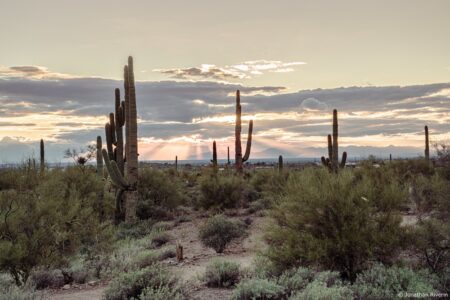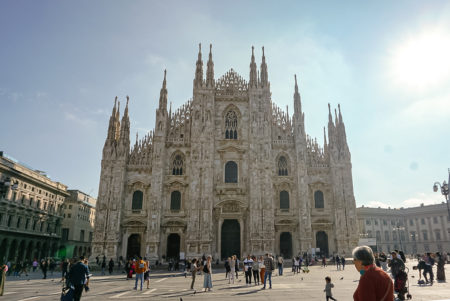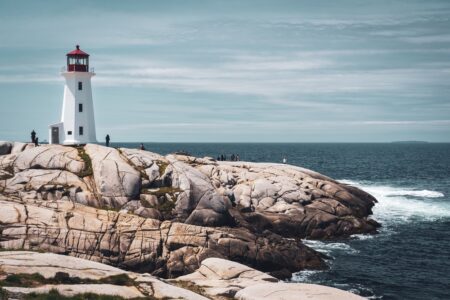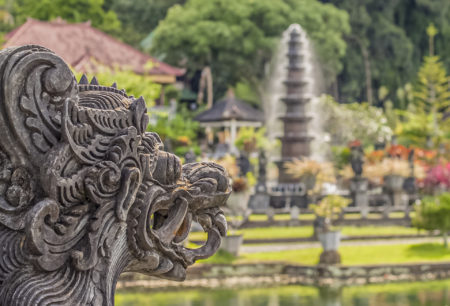
Discovering the Philippines and its 7,000 beautiful islands
More than 7,000 islands make up the Philippine archipelago and the main regions are Luzon, Visayas, Palawan and Mindanao.
*I think Palawan is part of the Visayas, but this island is so beautiful that it deserves its own description.
- Luzon: On this island, you’ll find the country’s capital, Manila. It is the commercial and industrial center, in addition to combining Spanish and Asian colonial architecture. Makati is the financial center of the country. The rice fields of Banaue, the lake and the volcano Taal are well-known as beauties of the country.
- Visayas: These islands located in the center of the country are made up of several small islands. Among the attractions are Bohol, Cebu and Boracay, the country’s star destination.
- Palawan: This island hosts Puerto Princesa, where Underground River, one of the 7 wonders of nature, is located, as well as Coron and El Nido, two beautiful areas very popular with tourists.
- Mindanao: This island also has beautiful beaches, as well as volcanoes, such as Mount Apo, but extremist groups are rebelling against the government. This area is not recommended by the Canadian government.
Some general information about the Philippines
Here is some information to know about the Philippines:
- The population is about 100 million (12th in the world) and about 12 million are expatriates, from all over the world.
- The country was ruled by Spain, followed by the United States and Japan.
- The majority of the population (about 80%) is (very) Catholic (thanks to the influence of more than 300 years of Spanish rule). There are also Protestants, Muslims, Buddhists and people with no religion.
- The main languages are English and Filipino (based on Tagalog).
- The country has a very high biodiversity, and ranks 10th among the megadiverse countries in the world.
Megadiverse countries are a group of countries in which the majority of the Earth’s plant and animal species are represented, and are therefore considered to be the richest in biological diversity on the planet.
Wikipédia
- The best time to visit the Philippines is the dry season between December and May.
- One must always pay attention to the weather in this country, located in the middle of the Pacific Ring of Fire, often affected by earthquakes, volcanic eruptions, typhoons and other phenomena.
In addition to beautiful landscapes, the Philippines are home to a kind and welcoming people. Despite the hardship life throws at them, they are always smiling and friendly. I have never known such a lovely people.
My itinerary in the Philippines
Quebec - Montreal - Beijing - Manila - Davao
This first part of the trip looks like a marathon:
- The bus from Quebec City to Montreal airport (3h30) and the wait of more than 3 hours on site;
- The 14-hour flight from Montreal to Beijing;
- The challenge of finding information at the Beijing airport (there was even a sign telling us to go left, but we had to go right) and the nearly 6-hour connection;
- The 5-hour flight to Manila;
- The 6-hour wait at Manila airport (almost everything was closed) and the change of terminal in the middle of the night with a shuttle that went through strange places (the 4 terminals are far from each other);
- The 2-hour flight to Davao.
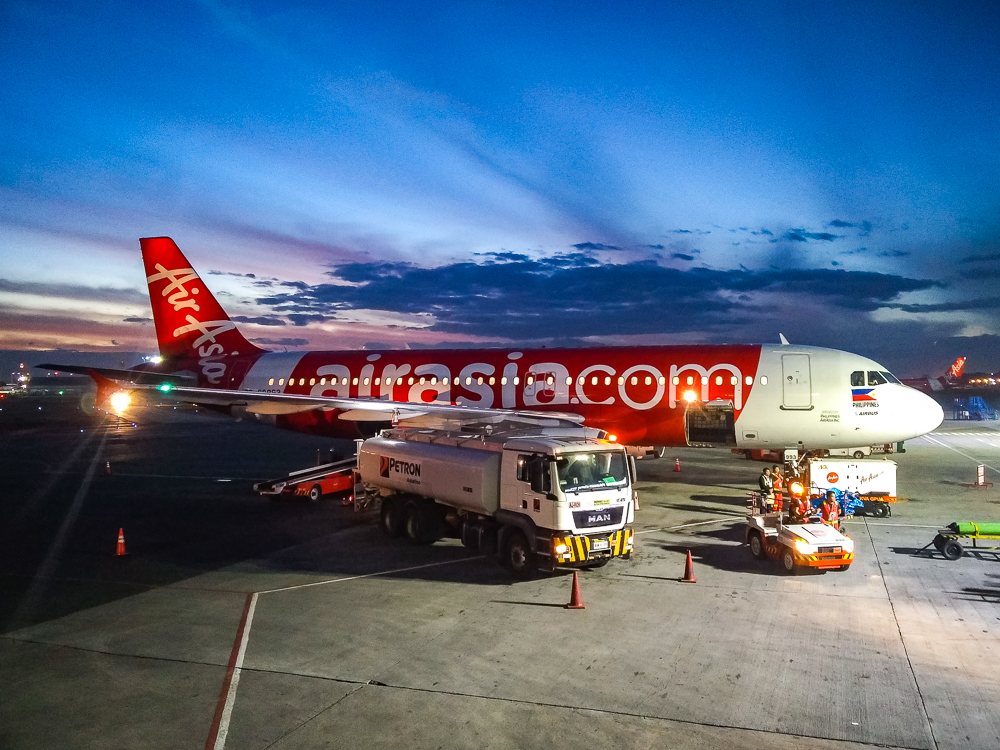
Davao
Davao is a city on the island of Mindanao. We went there because my brother-in-law is married to a Filipino woman and they have a house there.
When we arrived, in front of the house, there was a sign with our pictures, welcoming us. The poster was signed: Your family in the Philippines! Super cute!
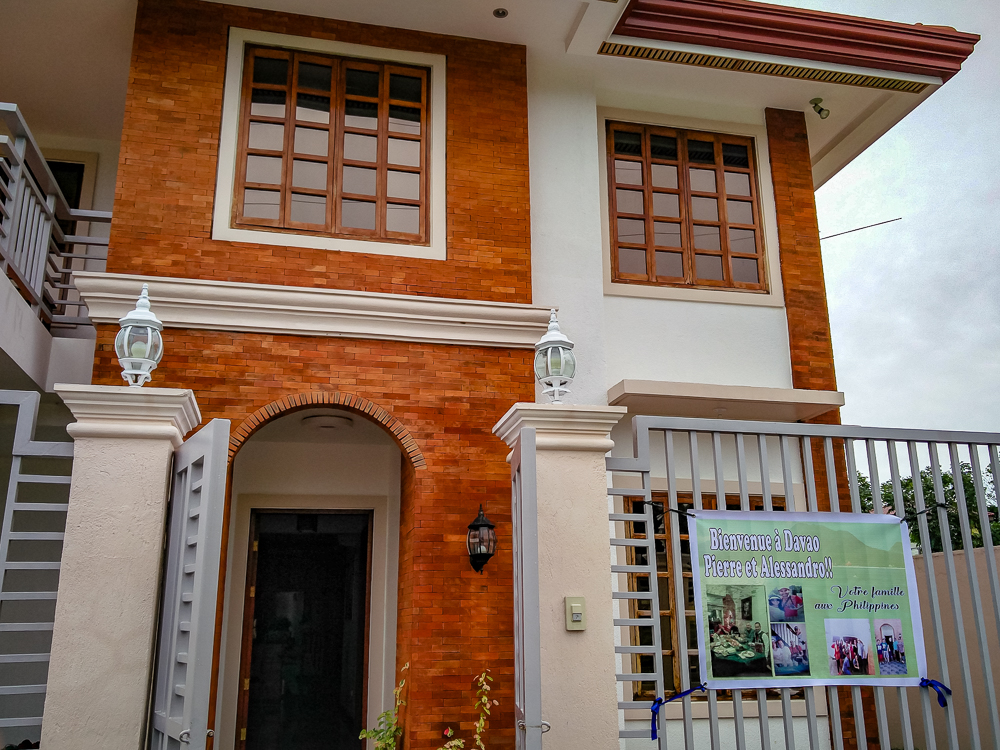
We stayed in Davao for a week to get to know the family.
We did some activities, including gift distribution (for them) and karaoke, which is really the national passion in the Philippines. The gang arrived Friday night and left early Sunday evening. We never once were less than 20 people.
For an only child like me, it was quite a family experience!

Their house is in a super nice complex inhabited mostly by foreigners. It is a barricaded mini-neighbourhood, with a guardhouse at the entrance, where security guards indeed work. The houses are very beautiful, far from the reality of the rest of the country. There is a club, with gym, sports fields, infinity pool and restaurant. We felt a bit like in the South (wealth next to poverty).
We went for massages several times, shopped in nice malls and tried some great restaurants. We even went to the local “Costco”, which is called S&R and is exactly like here.
We had a family mani-pedi-hair experience: there were 6 of us at the lounge and it cost about $10 per person (for about 3 hours). This was a first for me.
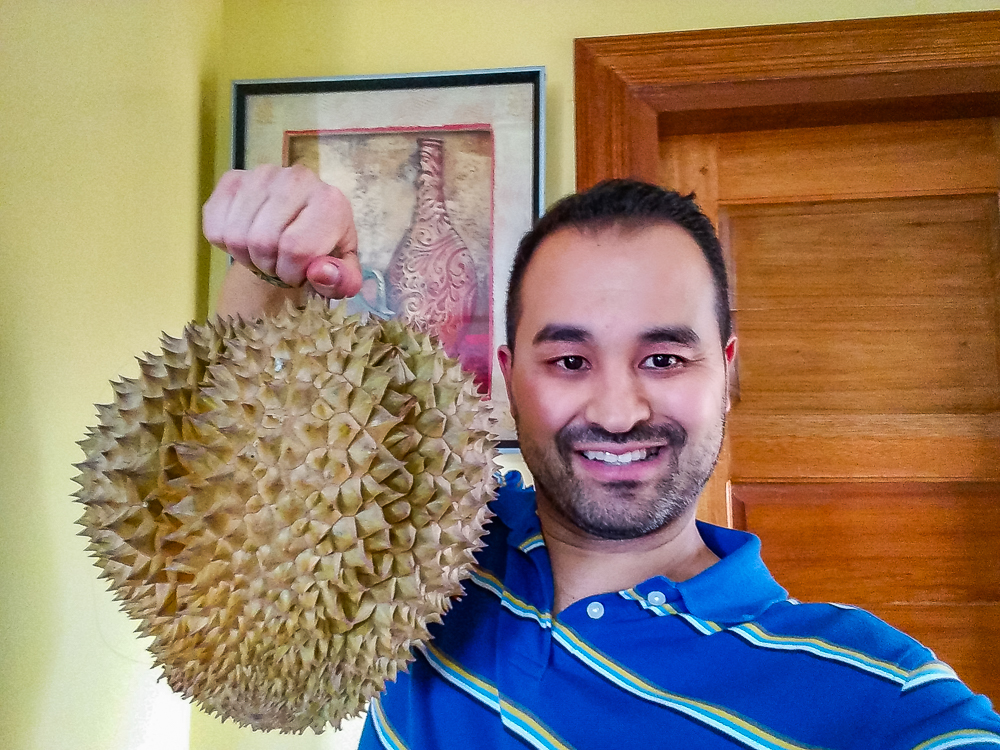
In Davao we visited :
- Crocodile Park. It’s a super sad place, and I regret the visit. Attractions where animals are visibly suffering should not exist.
- Eden Nature Park, a huge park, very beautiful and pleasant.
- The island of Samal. My brother-in-law chartered a boat for the whole family to spend the day. We were able to swim and snorkel there (there were many starfish). On the way back, he told us that this was the island where foreigners (including 2 Canadians) had been kidnapped (and beheaded) in 2015, by a Filipino Islamist extremist group called Abu Sayyaf. I don’t know if I would have had such a great day if I had known before.
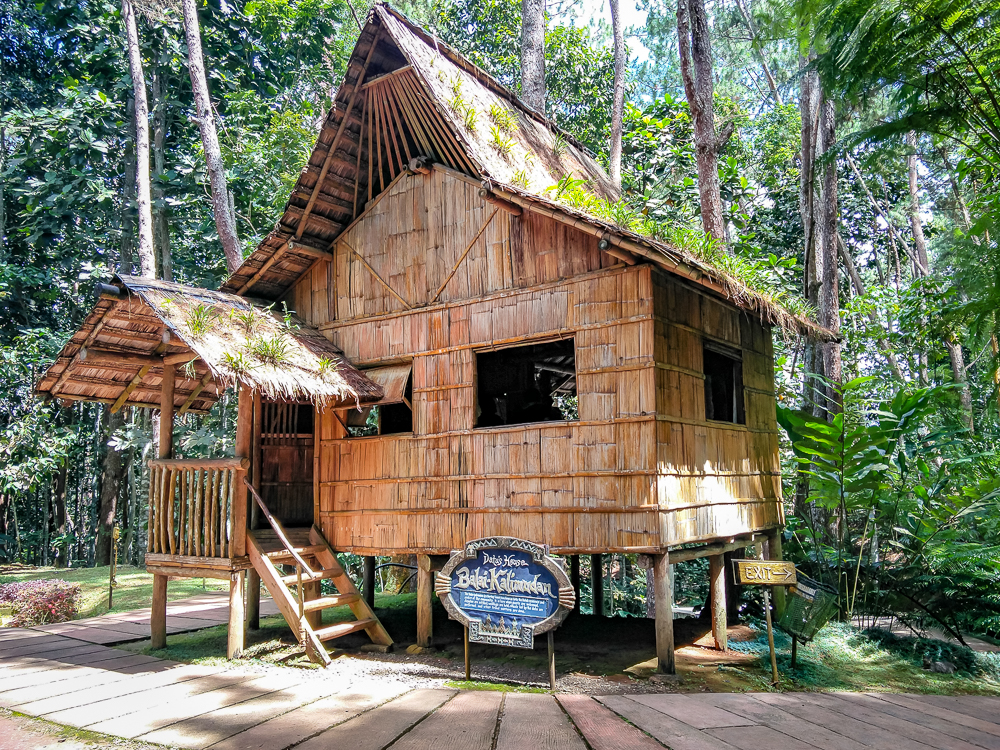
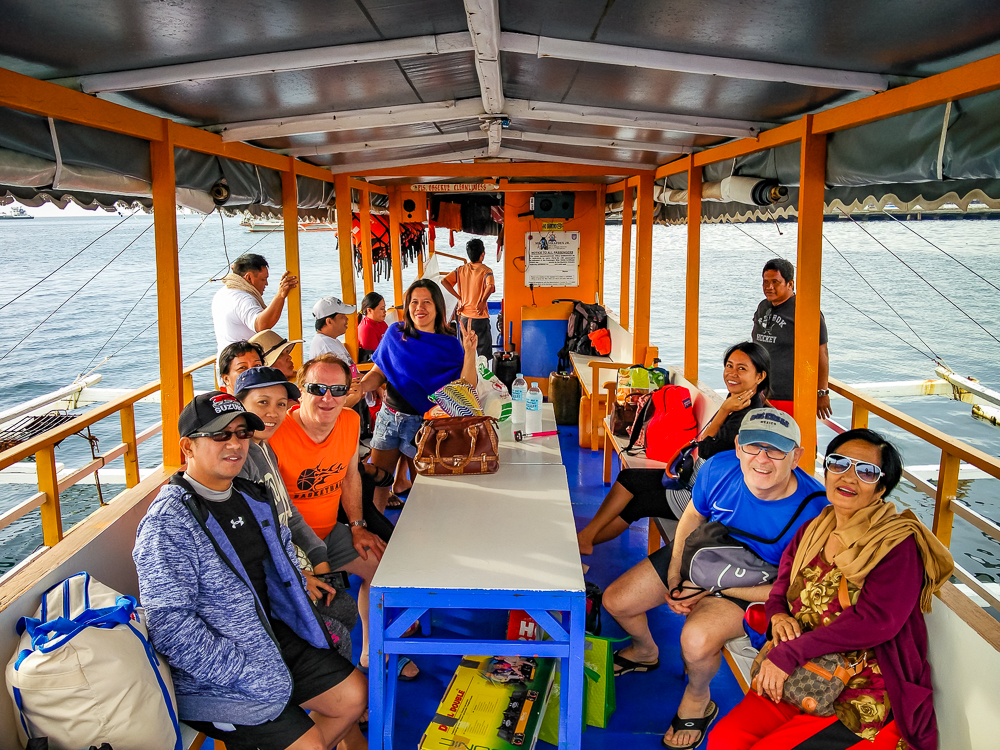
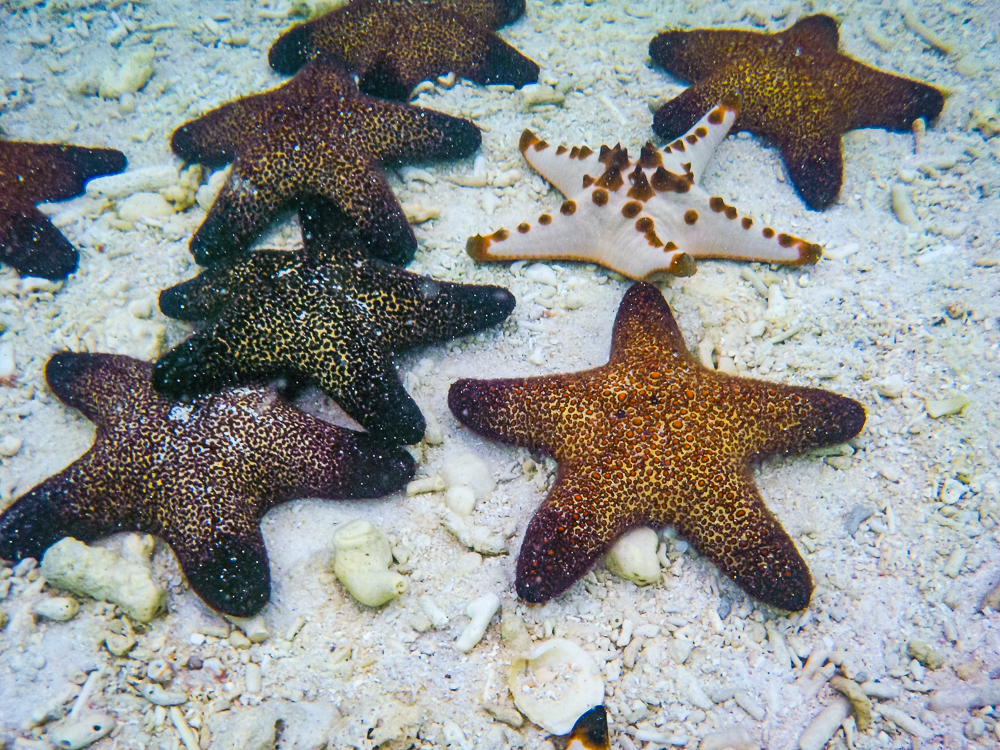
Fun fact
The girls said I looked like a Filipino singer, and as a result, they were always near me, taking pictures! 😀
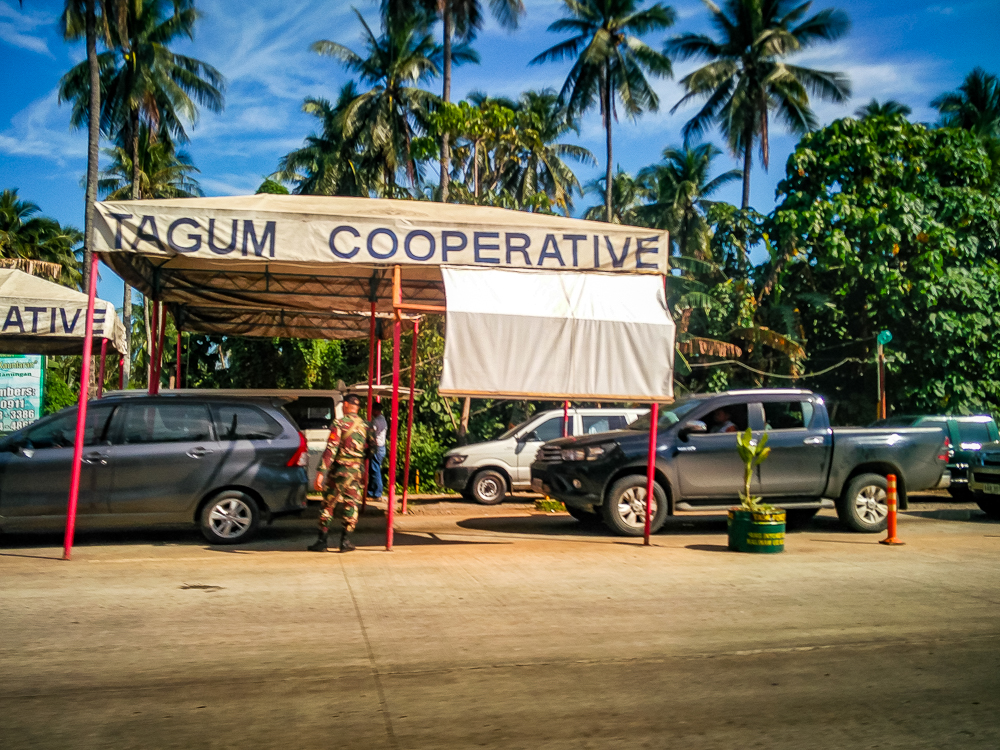
Davao - Cebu
Along with my brother-in-law, sister-in-law, her sister and her niece, we flew to Cebu, the country’s second oldest city. My sister-in-law’s other sister was waiting for us at the airport with a van. Quite a service!
We spent the day visiting the city:
- Monument to Lapu-Lapu (a national hero who resisted the Spanish colonists);
- Monument to the Battle of Mactan (the place where Lapu-Lapu and his men defeated the Portuguese navigator Fernando de Magellan (Fernão de Magalhães in Portuguese);
- Taoist temple of Cebu (where you have a nice view of the city);
- SM Seaside City Cebu (huge mall next to the sea – our malls are pitiful compared to malls in Asia!)
- Chapel of San Pedro (opposite the mall);
- Lantaw Restaurant, near the mall. We loved it!
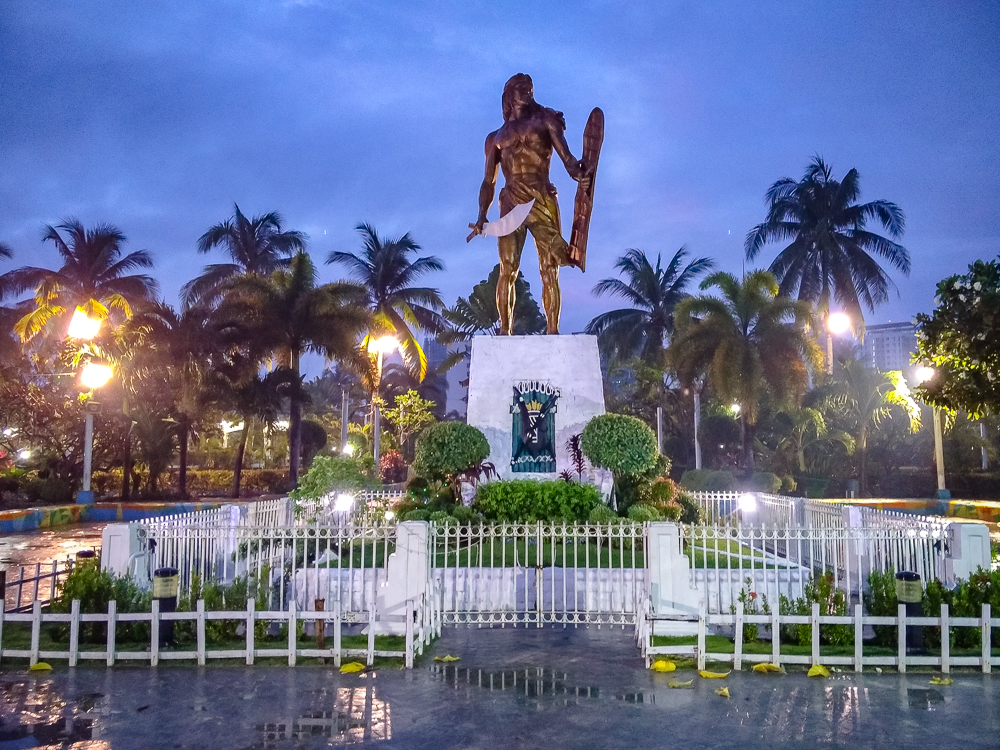
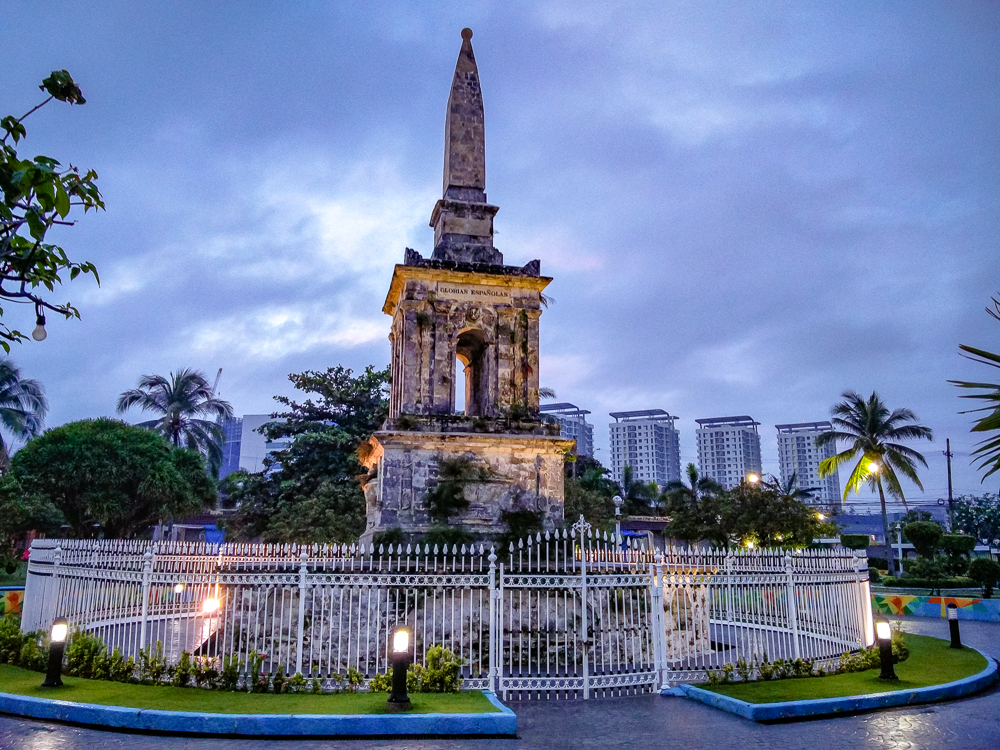
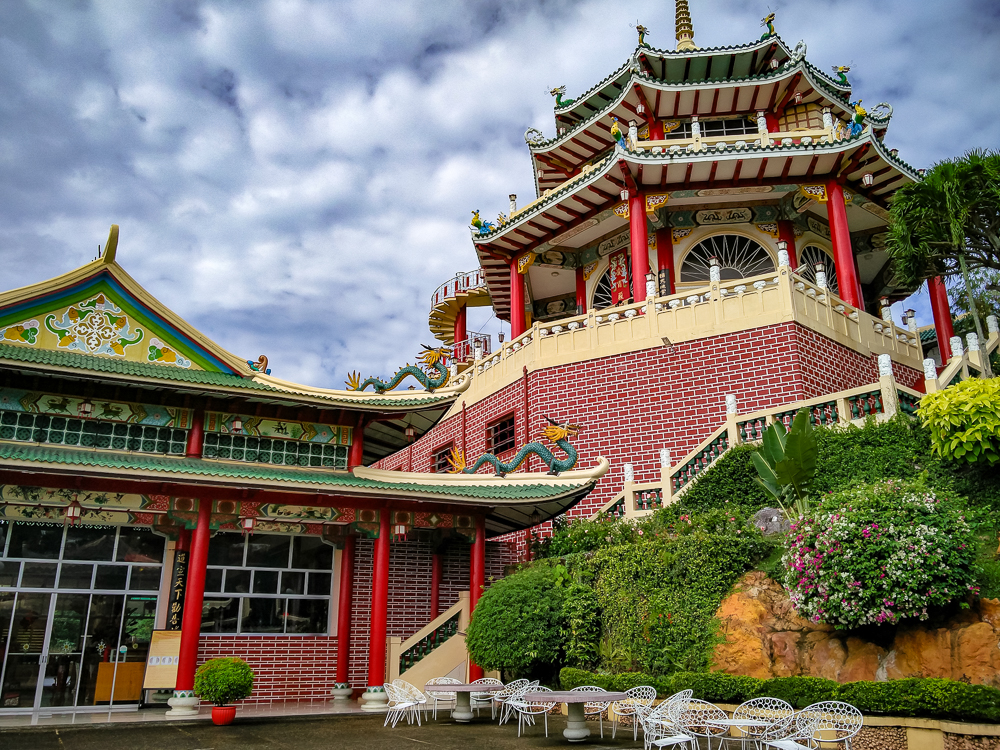
Colonial downtown:
- Basilica of the Holy Child of Cebu (Santo Niño);
- Magellan’s Cross (brought by Spanish explorers in 1521, marking the beginning of Christianity in the Philippines);
- Cebu Heritage Monument (monument that shows the history of the city from the conversion to Christianity to modern times);
- Yap-Sandiego ancestral house (historical house built in the 17th century);
- Fort San Pedro (Spanish stone fortress from 1738);
- The ferry terminal, to buy tickets to Tagbilaran (Bohol Island).
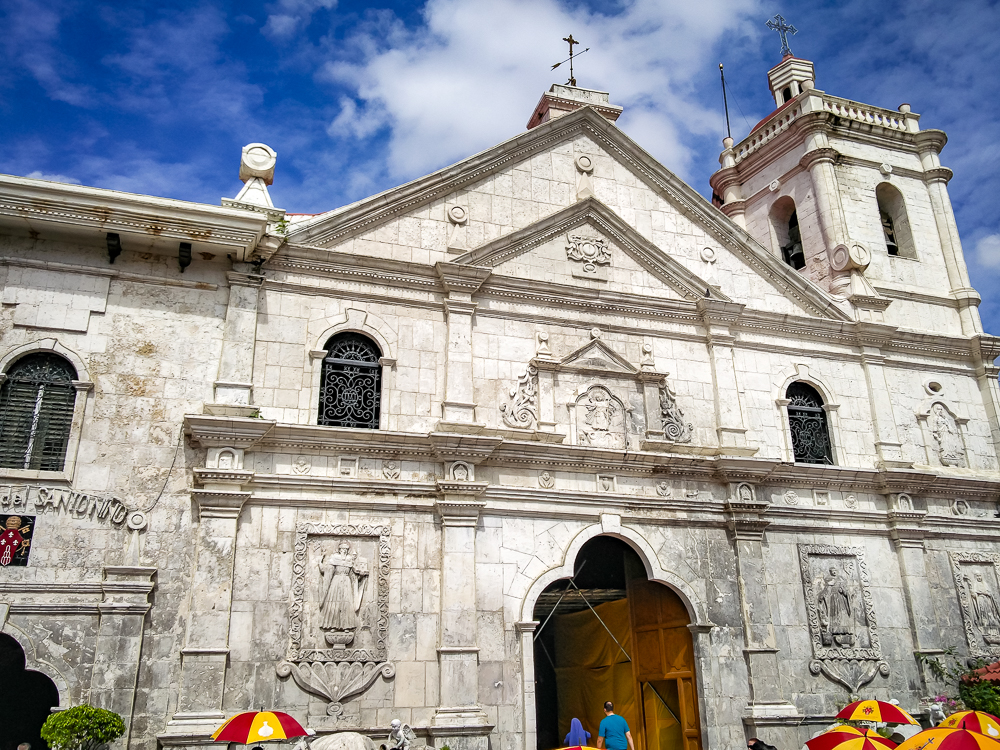


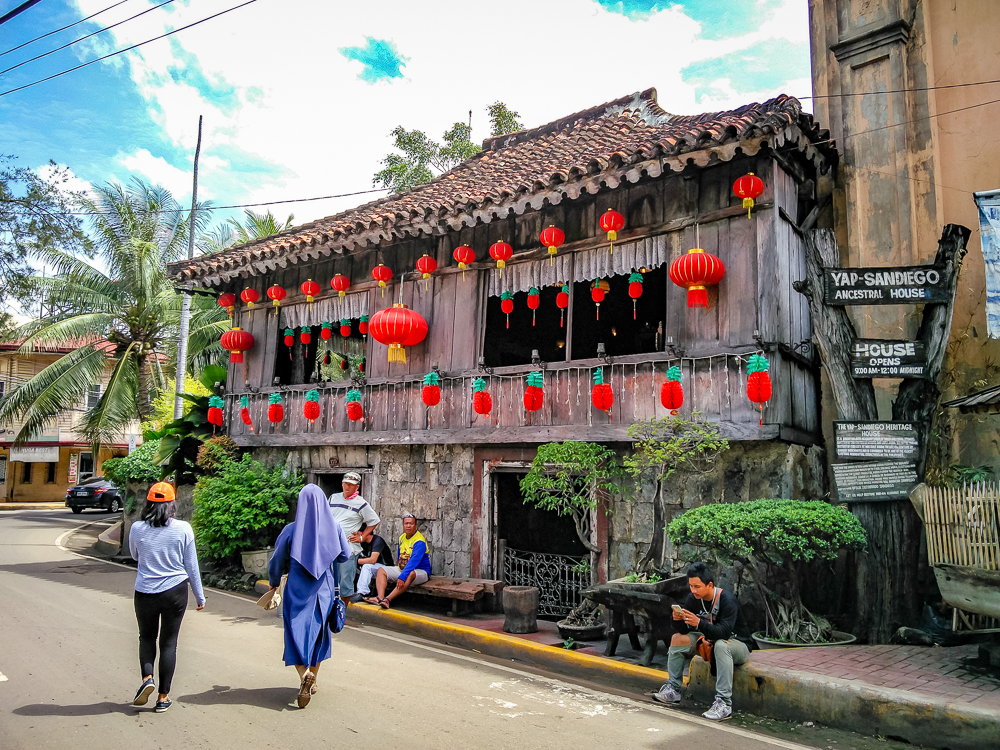
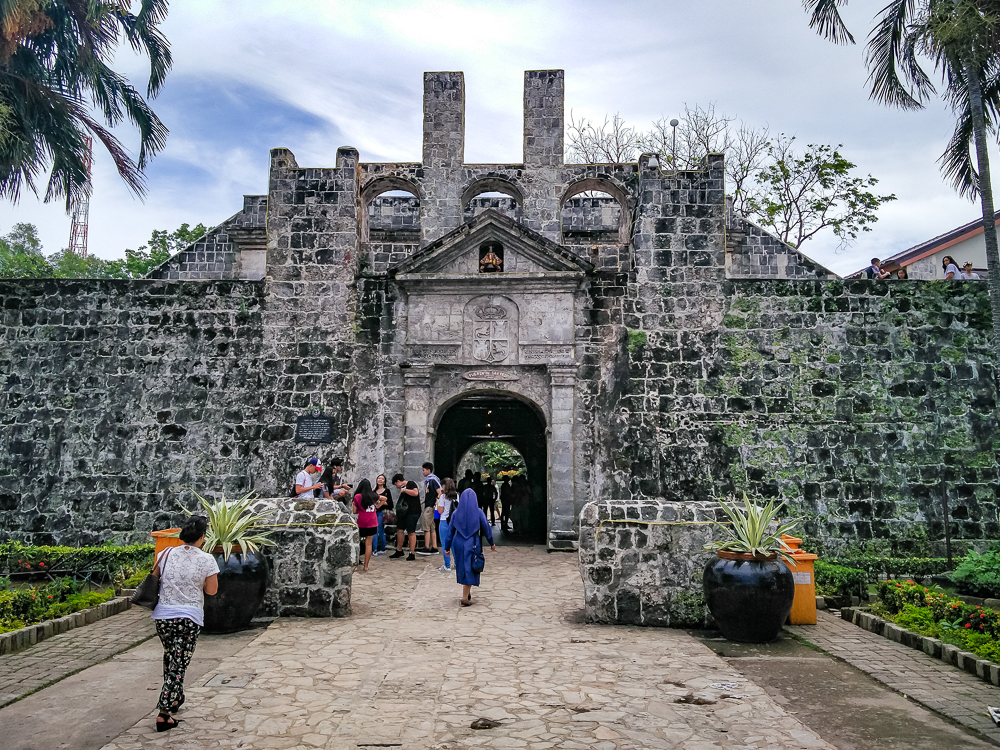
My sister-in-law’s sister is a nun in Cebu. We had dinner where they live, with all the nuns. Another different experience!
Anecdote:
Since travel shapes youth, anecdotes are an essential part of our adventures.
At the mall, we entered a shop. I told the saleswoman that I didn’t know what Asian size I should wear. She said to me: “I would recommend XL, sir, because you are very tall” (I am 5’8 / 1,73m…).
I told her that it was not me who was tall, but she who was short. We both started to laugh.
Cebu-Tagbilaran-Panglao-Bohol
We took a ferry to Tagbilaran, on the island of Bohol (about a 2-hour trip).
On arrival, a van was waiting for us. It’s a good thing my sister-in-law had organized the trip. Although many people in the Philippines are fluent in English, communication was sometimes complicated, with our accents and theirs.
We stayed in a charming little hotel near the beach of Alona, on the island of Panglao. We took a tuk-tuk to go to the beach. This was our first experience with this charming transport.
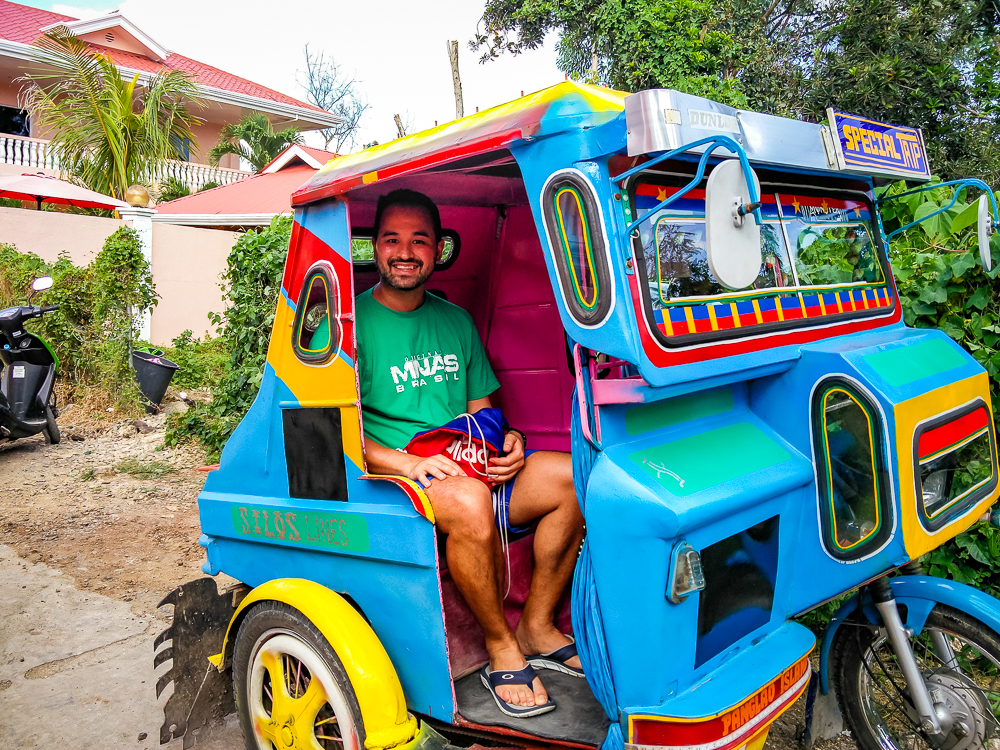
Once again, my sister-in-law organized our visits:
- Monument of the blood pact (Between the Spanish and the Filipinos in 1565);
- Baclayon Church (Partially destroyed by the 2013 earthquake);
- Tarsier Sanctuary (The tiny primate with huge eyes) – Another place to carefully consider. They say they take care of the tarsiers. The animals (very small and hard to see) were free-ranging (in captivity, they get stressed and kill themselves) and looked well cared for. If you decide to go there, you must not make any noise, nor take pictures with flash and especially not try to touch them.
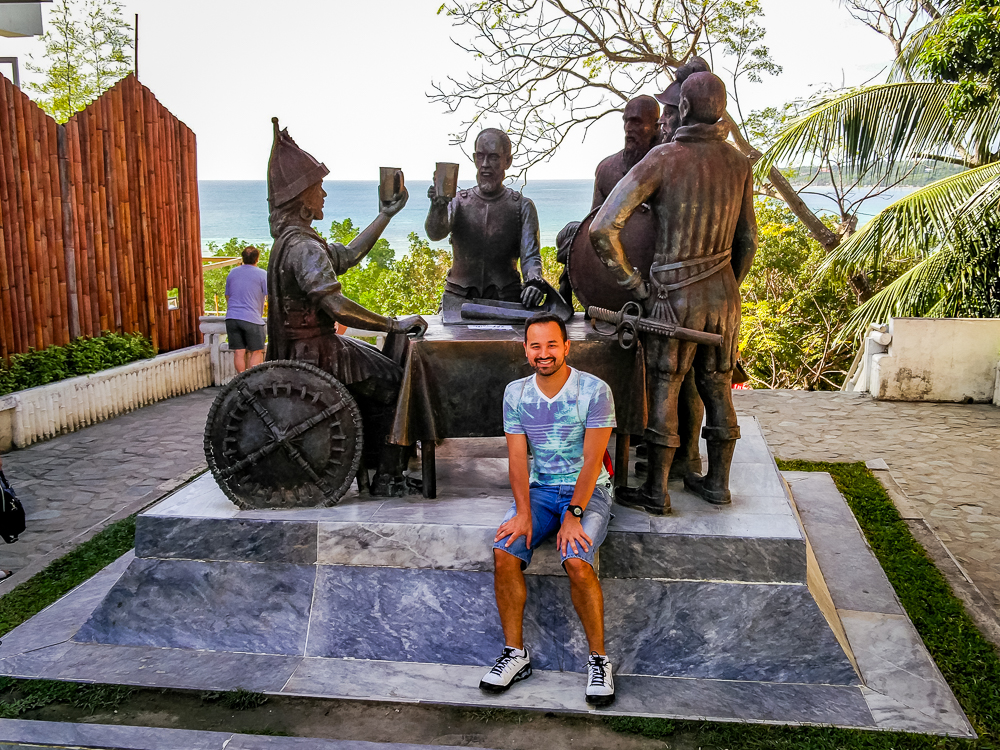
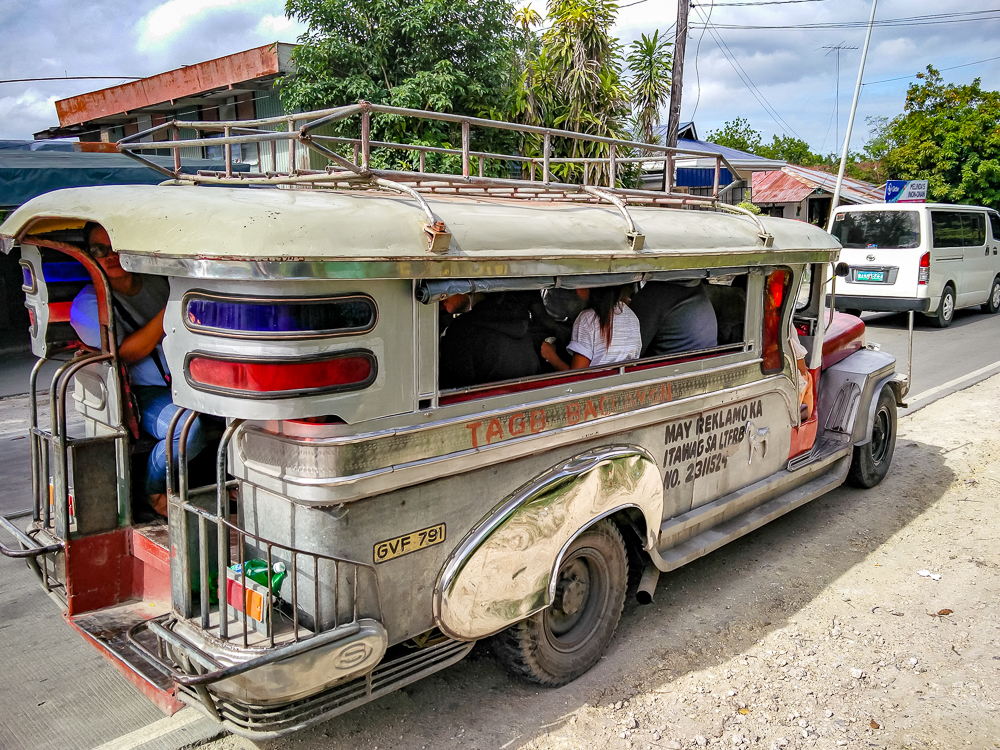

Very anxious, tarsiers are stressed by the human voice, a hand getting close or the flash of a camera. This can be enough to plunge them into distress and even end their lives.
They stop breathing and die slowly. If you put them in a cage, they want to get out, so they bang their heads against the cage, and it cracks because their skull is so thin.Wikipedia
- Church of St. Peter (Destroyed almost entirely. We did not enter);
- Xzootic Animal Park – We didn’t want to go, but apparently it was part of the package and we had no choice. The animals looked like they were asking for help. Some of them were in cages or in concrete prison-like cells. 🙁


- Floating Restaurant – Loboc River Cruise: A quaint but very typical activity. At the end, we were treated to a performance by local children. I hope the money we leave is well spent;
- Butterfly Sanctuary – This one looked okay. It was more like a park;
- Chocolate Hills – This geological formation consists of 1268 cone-shaped hills of similar sizes. These hills are spread over more than 50 square kilometres. Very interesting;

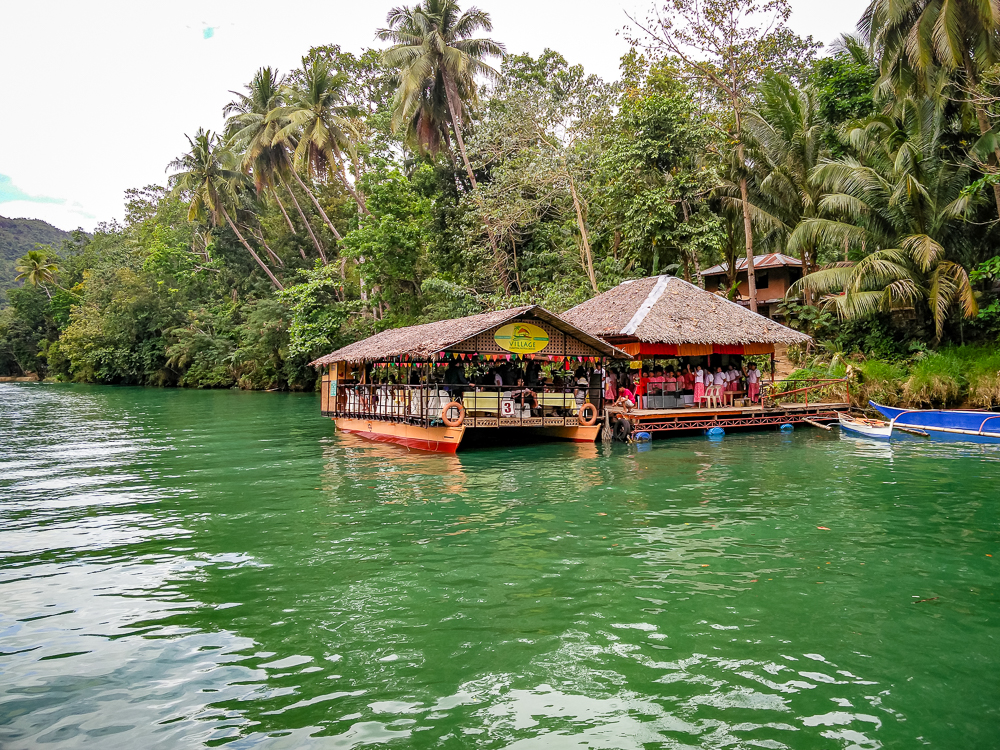

- Man-made Forest – A road with trees on both sides. A quick stop for a photo;
- Sevilla Suspension Bridge (a bamboo suspension bridge) – On the other side, there is a small market for trinkets. They are waiting for you! Some people begged us to buy something. It’s heartbreaking;
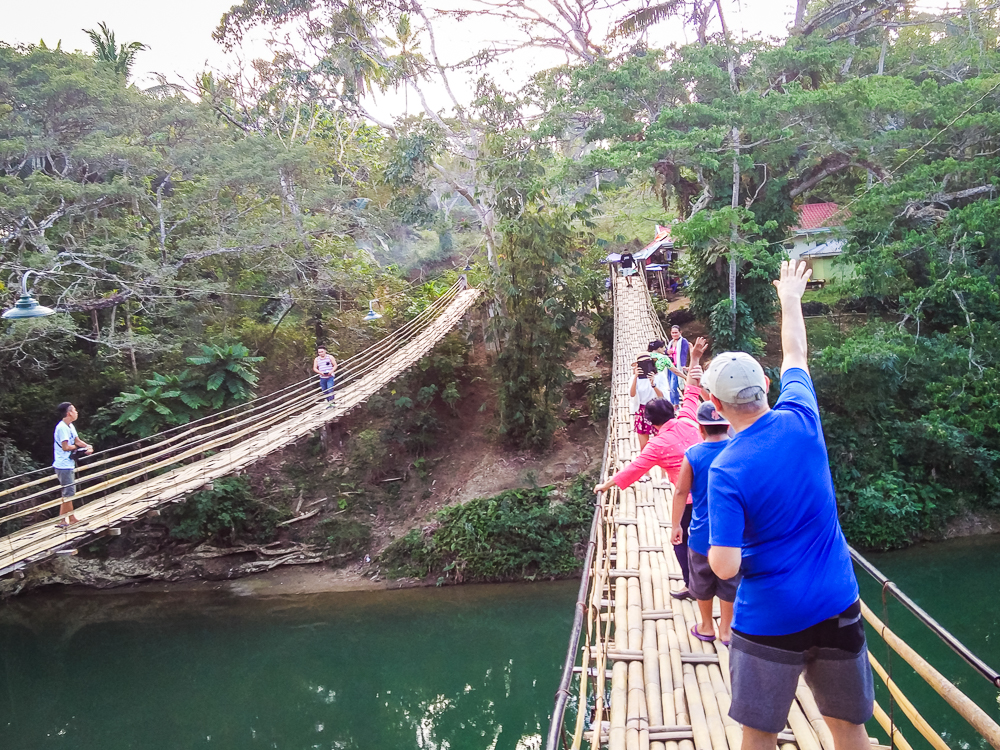
- Parish of Saint Augustine;
- Nova Shell Museum (a museum of shells);
- Hinagdanan Cave (you can bathe or just visit. We bathed);
- Mag-Aso Falls (we bathed in the turquoise water);
- Church of Our Lady of Assumption (partially destroyed);
- Bohol Bee Farm Resort (for dinner overlooking the sea).
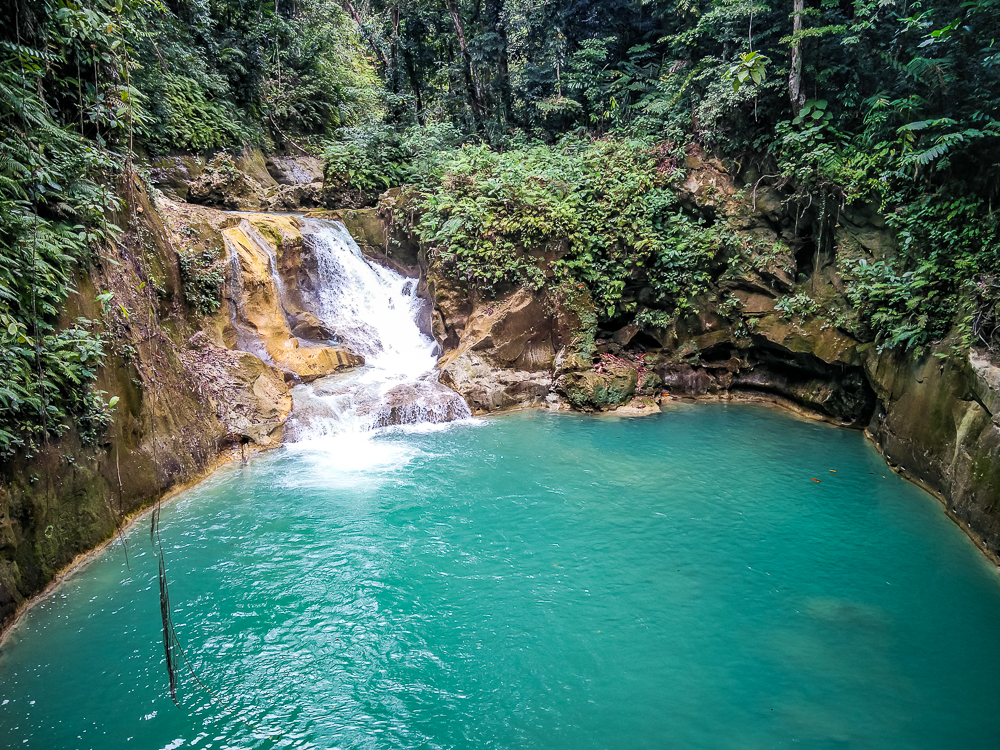
Cebu-Boracay (Caticlan)
After our stay in Bohol, we took the ferry back to Cebu. My sister-in-law was already at the ferry terminal with the van, to drive us to the airport.
My brother-in-law and the family went back to Davao and we took a flight to Boracay, the star island of the Philippines.
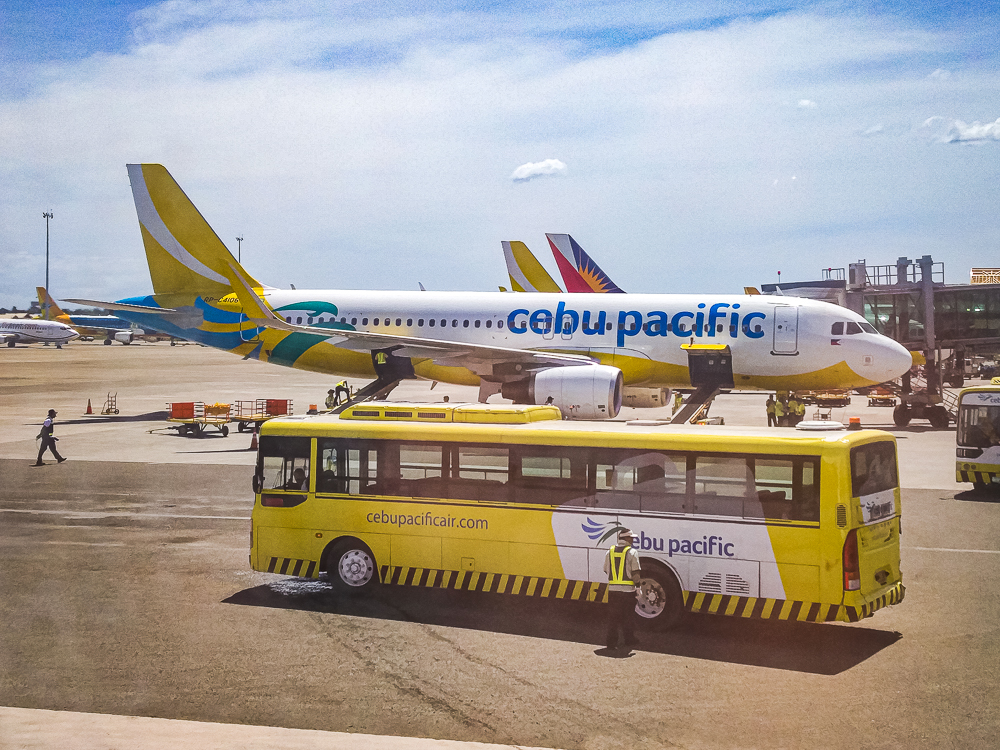
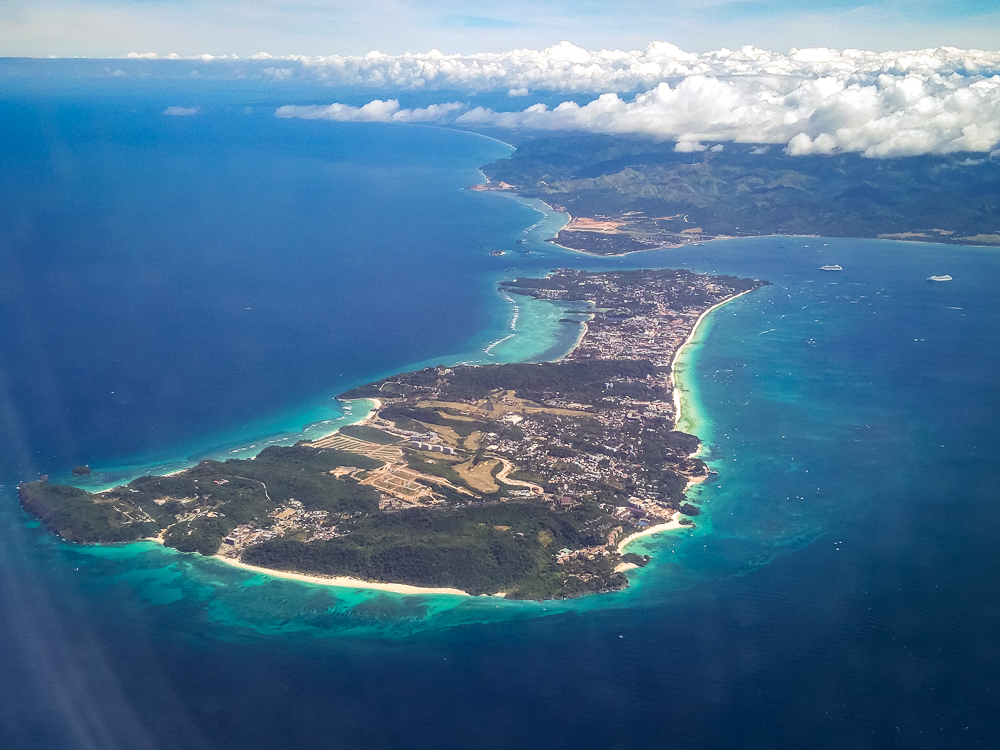
When you get off the small boat, you can: take a tuk tuk, walk or take the hotel shuttle.
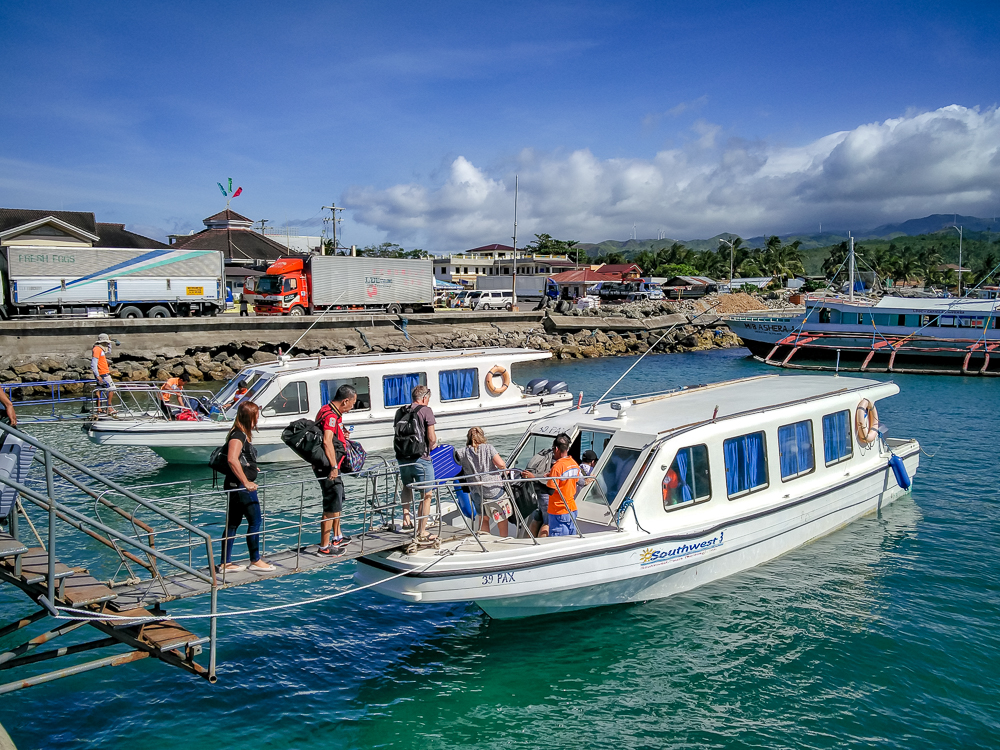
The main beaches in Boracay are White Beach, Bulabog Beach and Puka Shell Beach.
White Beach is the main beach, where the vast majority of hotels, restaurants and shops are located. It is divided into 3 stations:
- Station 1: more quiet, with a beautiful beach and more refined hotels;
- Station 2: busier, with restaurants and bars;
- Station 3: quieter and more affordable.
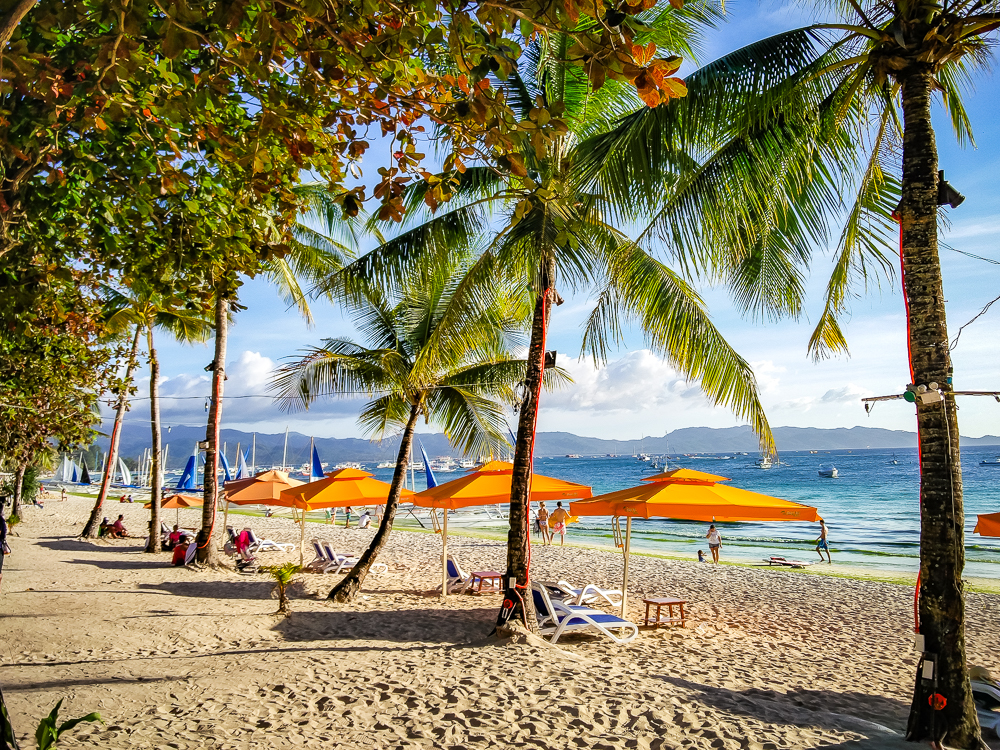
Bulabog Beach is the beach for kitesurfing and windsurfing. It is not very good for swimming.
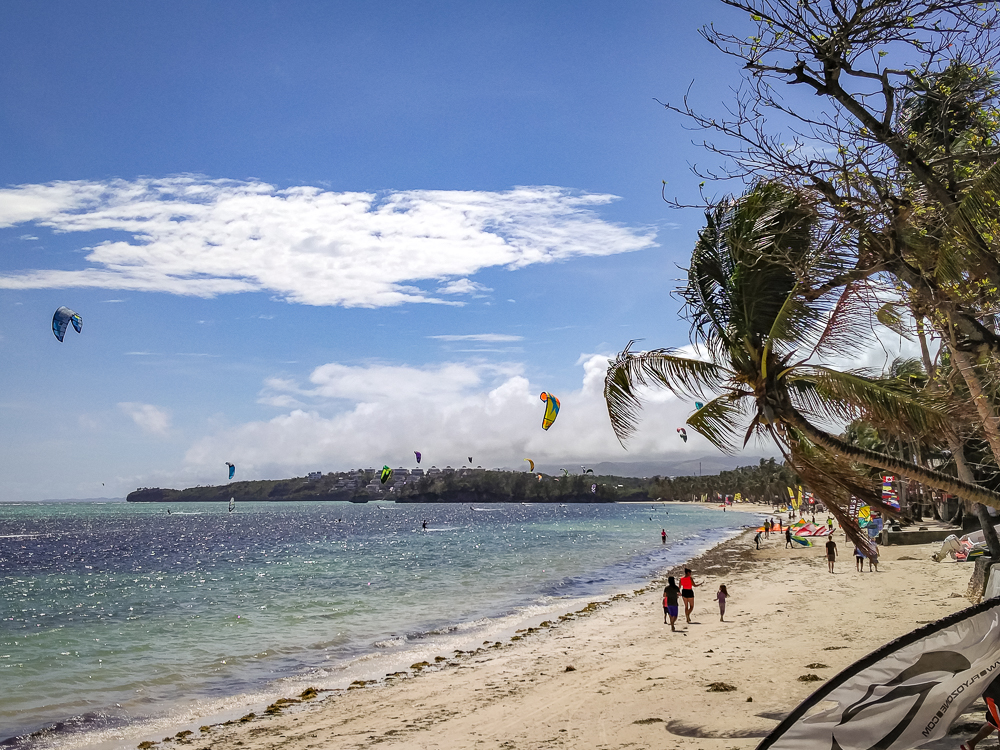
Puka Shell Beach is a large, sandy beach in the north of the island. It is accessible by tuk tuk, but there are excursions that stop there as well.

We chose station 3, which is quiet, affordable and within walking distance of the other stations.
Our hotel was super nice, affordable and all the rooms had doors facing the pool. The hotel is H-shaped, and the pool is in the middle.
This is a hotel that, like many in Boracay, has one entrance from the street and another from the beach. The restaurant’s terrace overlooked the beach. It was nice to have breakfast outside every morning.
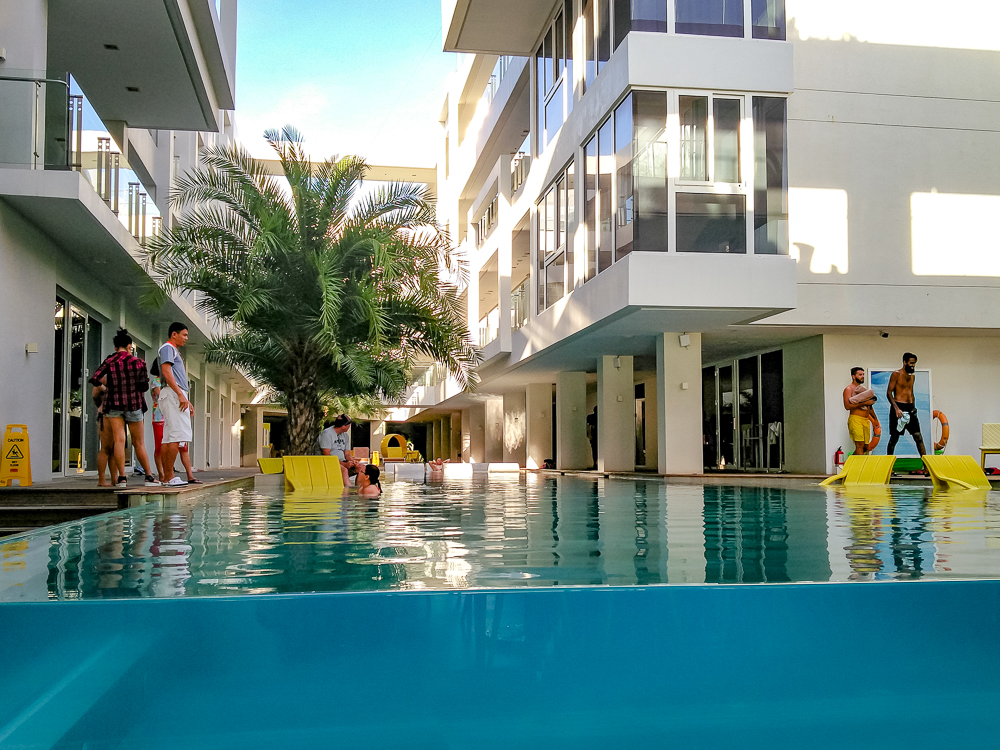
One day, we were approached by a young boy at the beach. He was looking for clients for companies. He suggested we go for Island Hopping the next day. We agreed, on the condition that we pay the next day (you know, with so many dishonest people, you end up not trusting anyone).
In the end, everything went well and we had a great day. We visited:
- Puka Shell Beach;
- The we stopped for diving;
- We had lunch at the beach;
- Crystal Cove Island (You could choose between visiting the place or staying at the beach).
We were back at the hotel in time to get ready for the sunset, which is beautiful in Boracay.
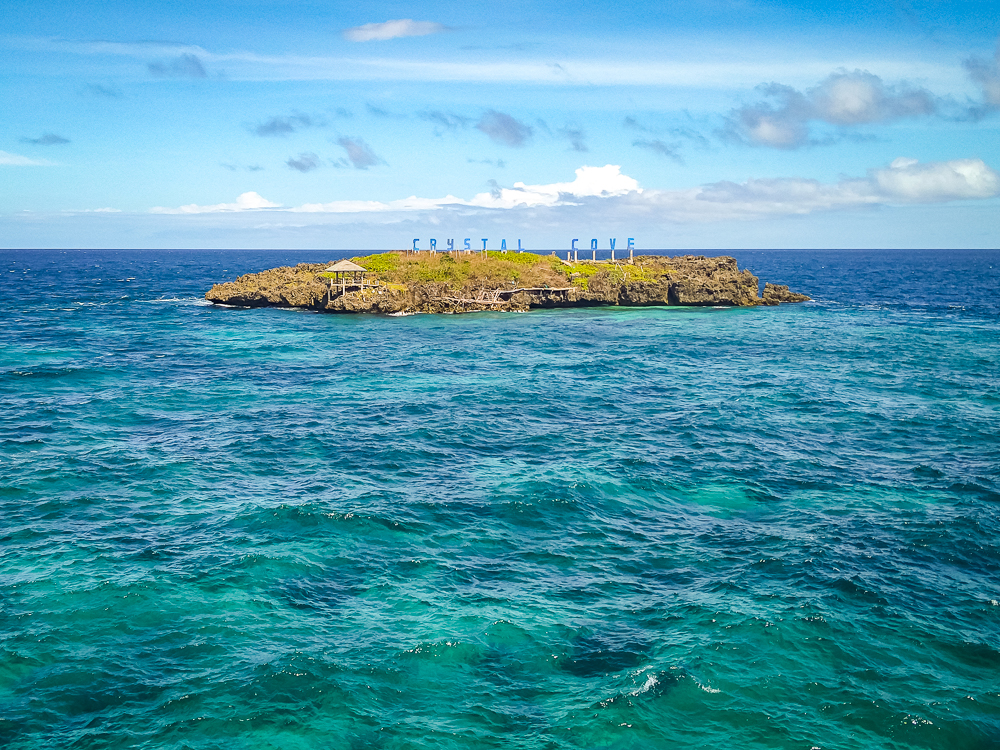


Another day, we took a tuk tuk to go around the island. We visited:
- Bulabog Beach;
- Mount Luho (to have a nice view of the island and take a quaint picture in a heart made of flowers);
- Ilig-Iligan Beach;
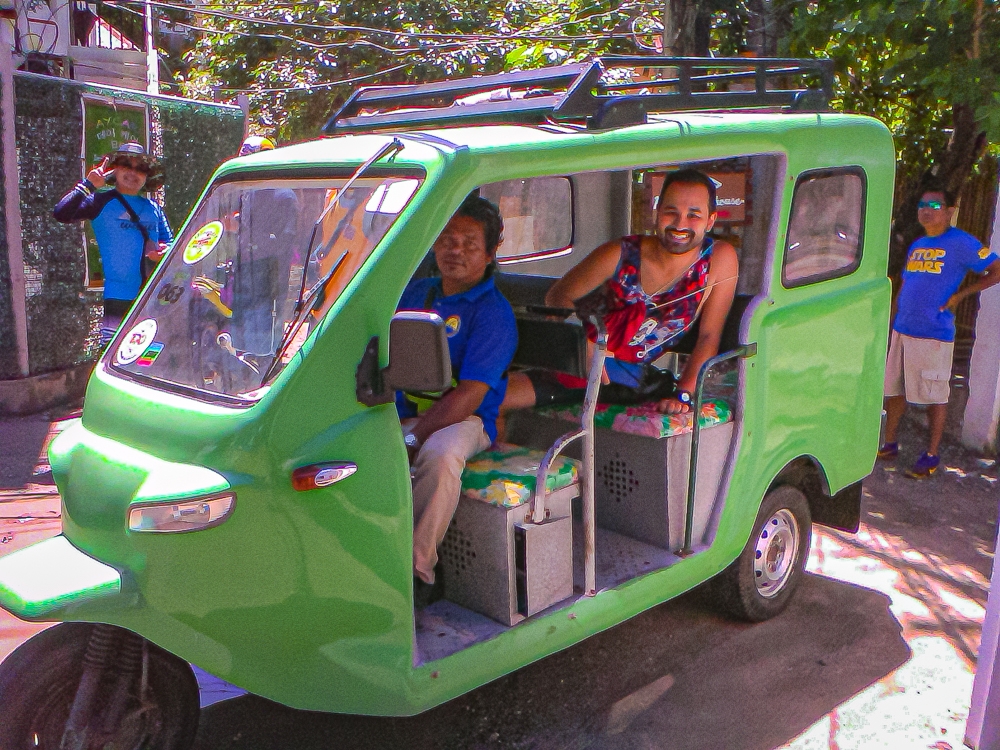
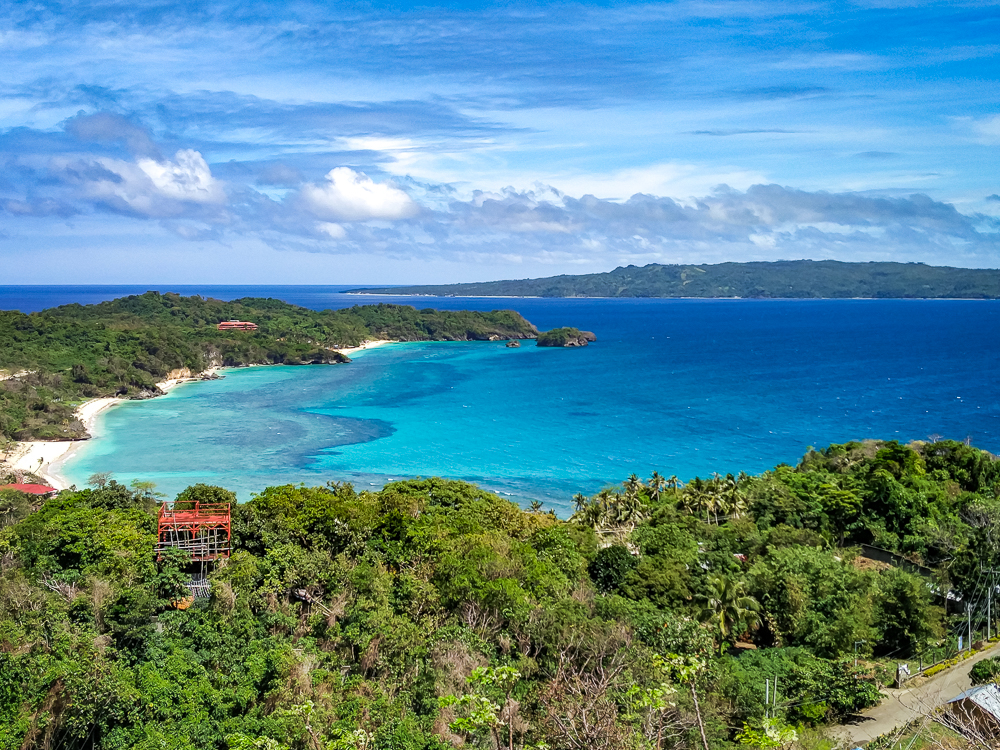
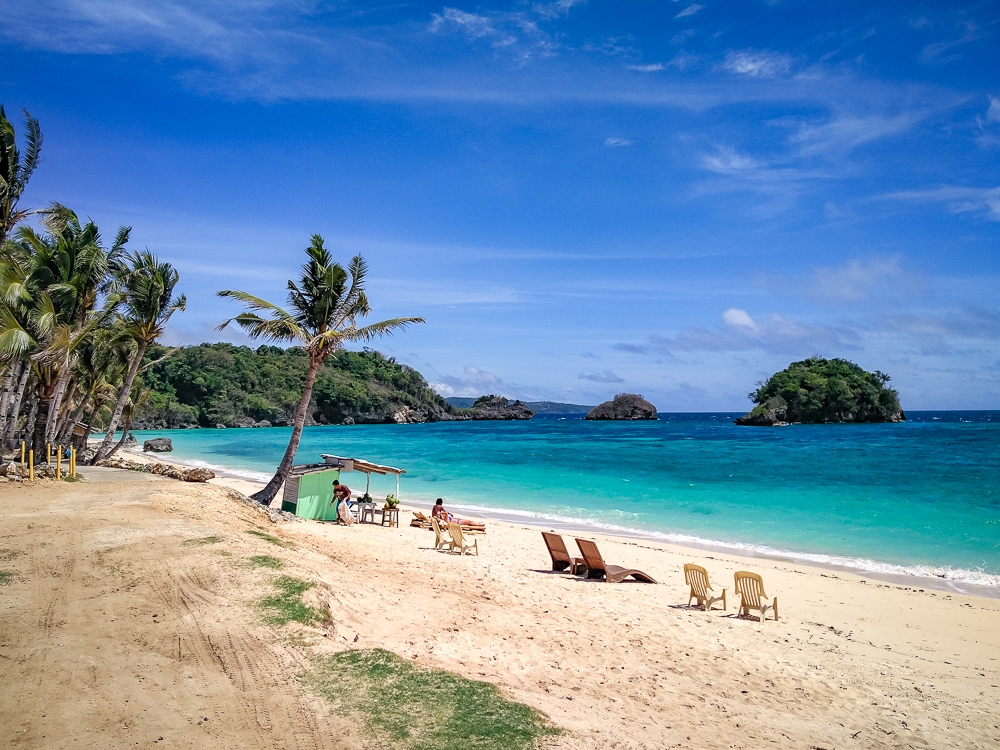
- Puka Shell Beach;
- Diniwid Beach;
- Virgin Mary statue at Willy’s Rock, Station 1, where you can also see the famous sand sculptures with the word Boracay (tip the people before taking pictures);
- We got off at D Mall Boracay, an outdoor mall, looking for a place to eat.

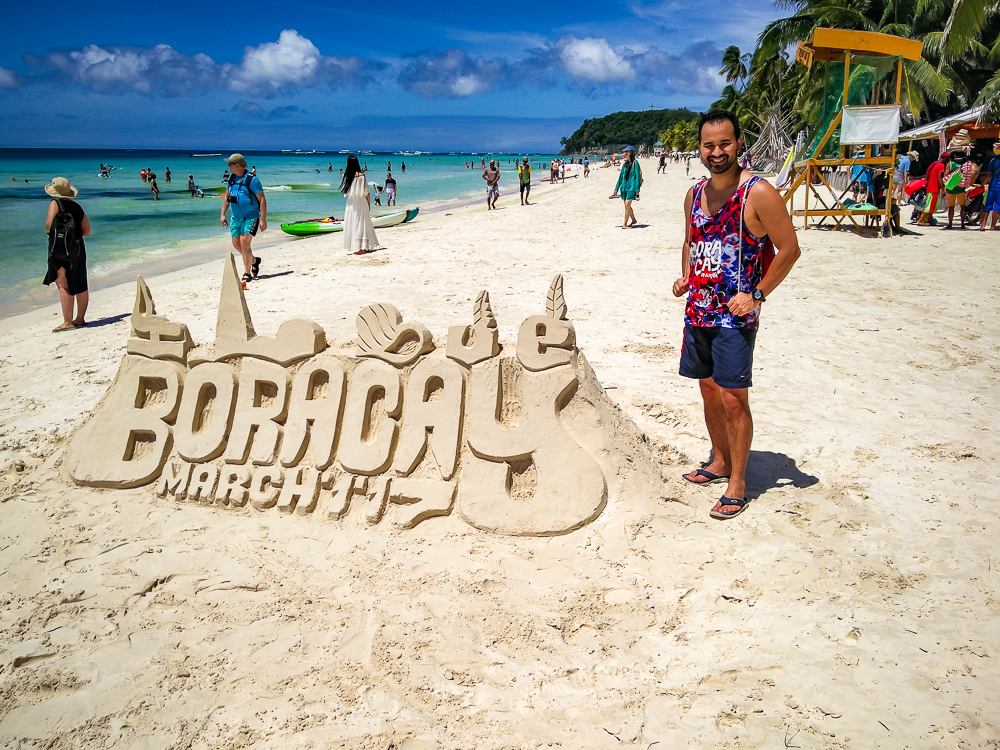

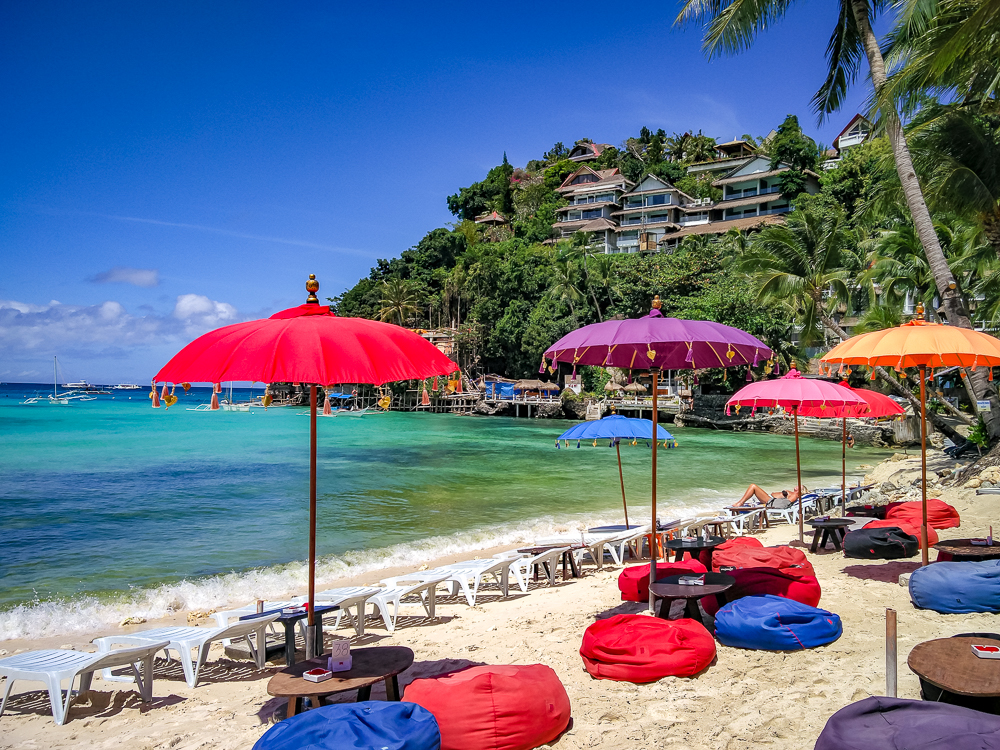
At the end of the day, it was fun to walk on the sand from Station 3 to Station 1, and on the way back, see the sunset at Station 2 and then look for a restaurant or bar with chairs on the sand for drinks or dinner.
There are often presentations by local artists, who are trying to make a living, as best they can. Remember to encourage them!
For whoever might be interested: at Station 2, they rent out mermaid tails for photo shoots. No, I didn’t do it.
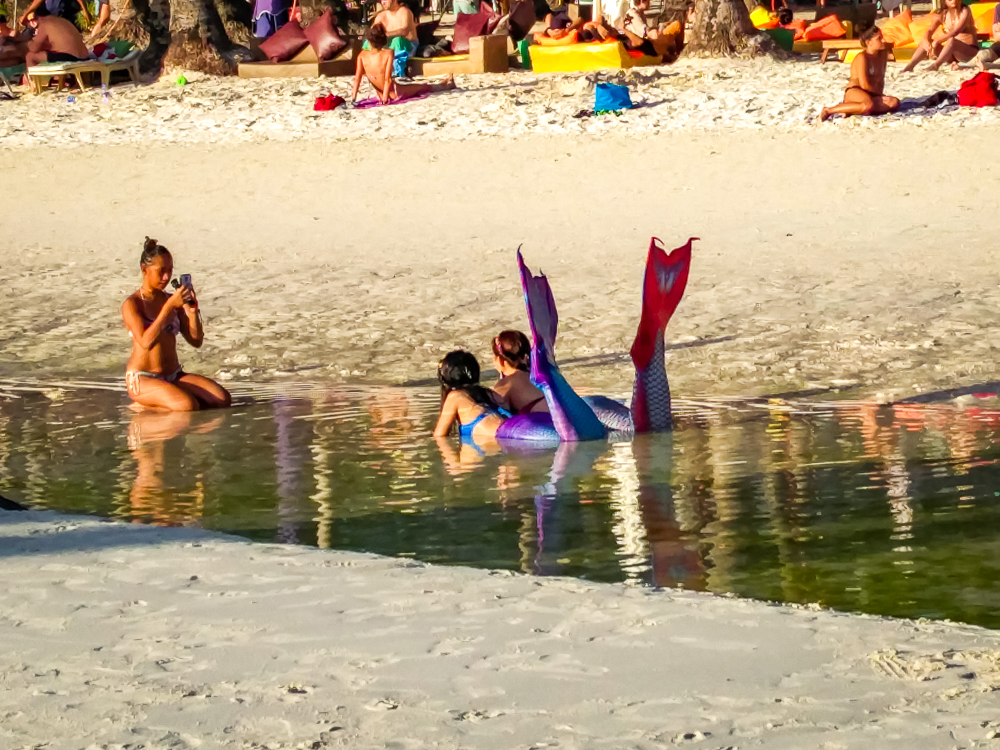

Boracay-Puerto Princesa
We took the hotel shuttle, to take the small boat towards the airport of Caticlan. Destination: Puerto Princesa.
My brother-in-law and sister-in-law had already arrived in Puerto Princesa, but this time the van booked by my sister-in-law was not there. We asked for help from the tourist police, to call my sister-in-law and take a taxi to the hotel she had booked.
The next day, we went on a tour, organized by my sister-in-law:
- Mangrove of Sabang (a nice man made us visit the area, in a small boat);
- Undeground River – The 8.2 kilometre long underground river has breathtaking cave formations, stunning limestone cliffs and crystal clear waters. However, only a portion of the river, about 4.3 km, can be explored by tourists. You must not be afraid of waves, monkeys and bats – We take a boat to the starting point of the tour, there are monkeys there and hundreds of bats in the cave.
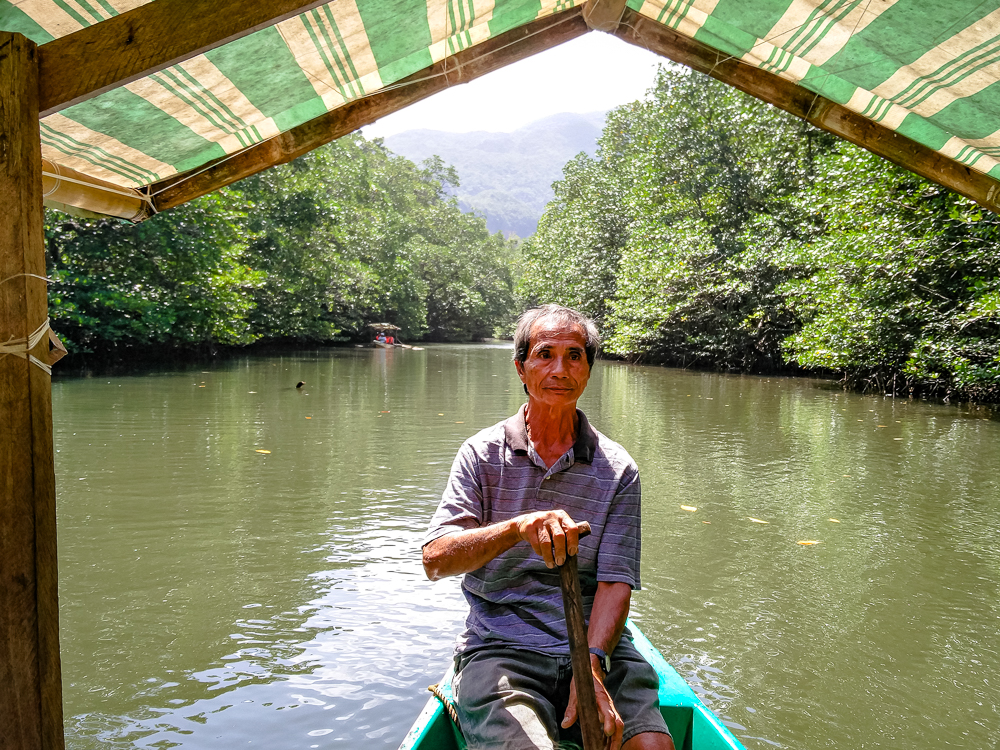
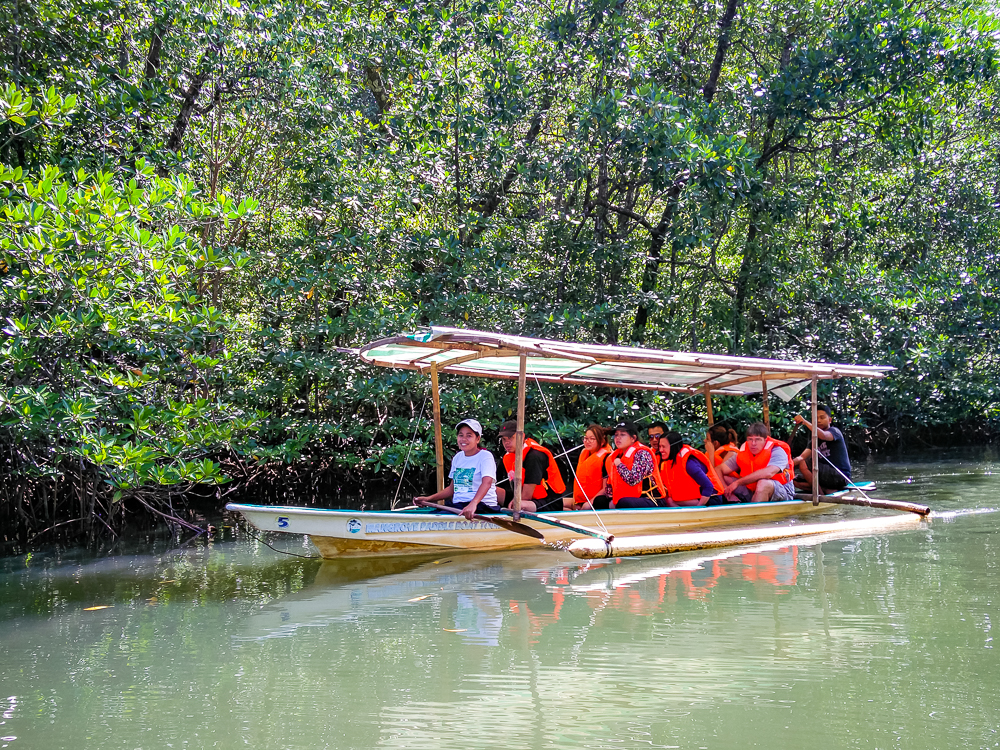
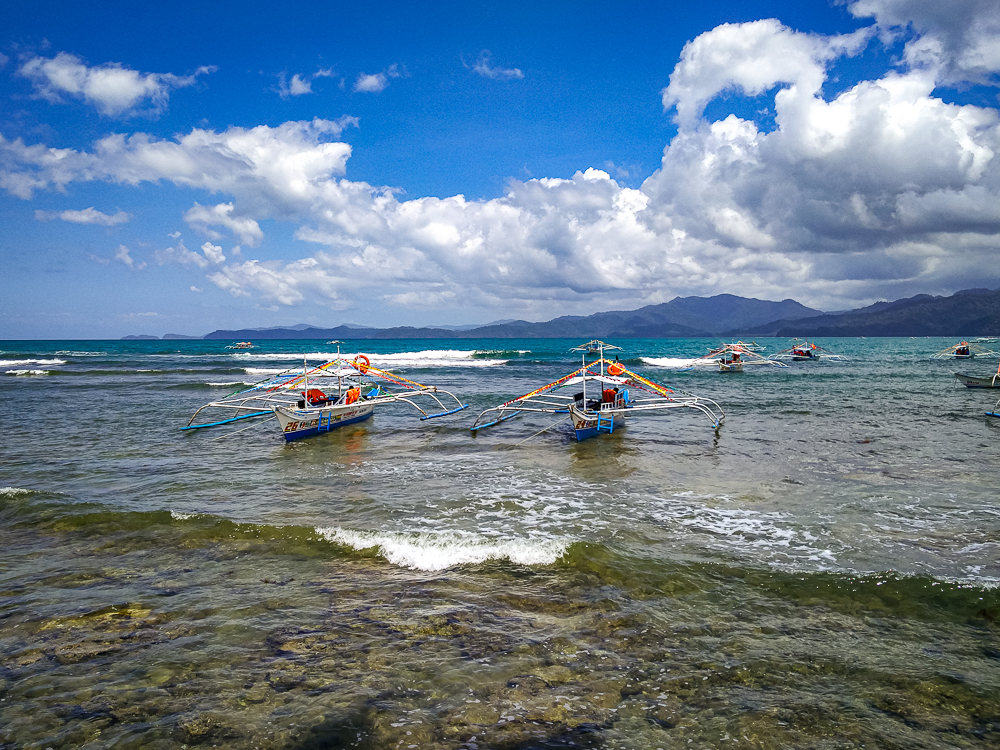
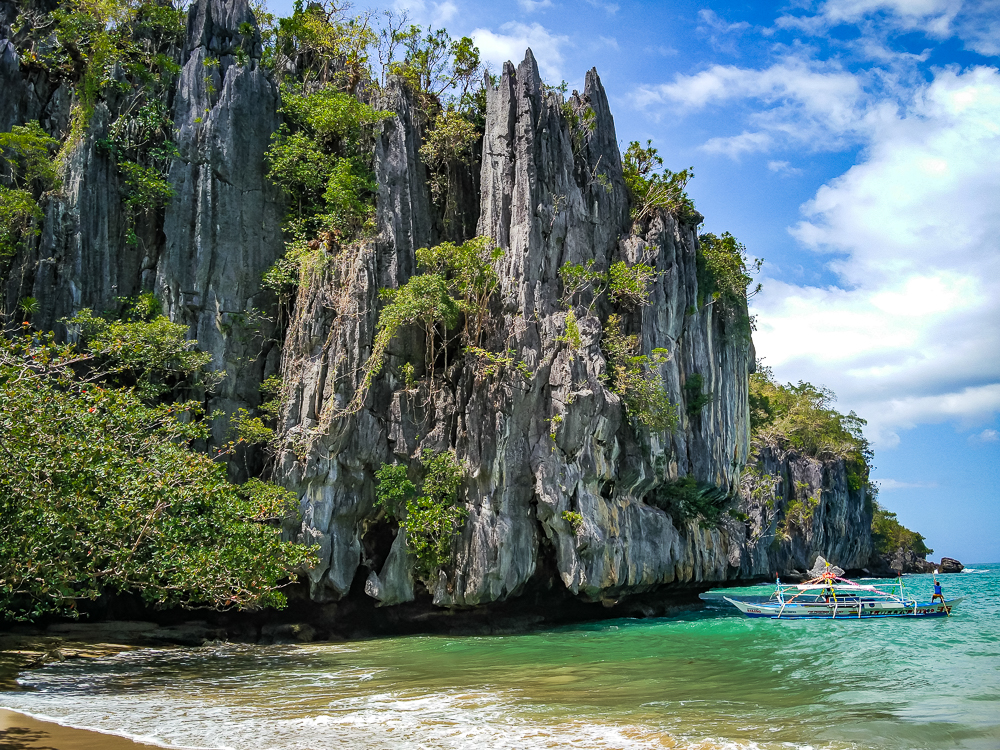


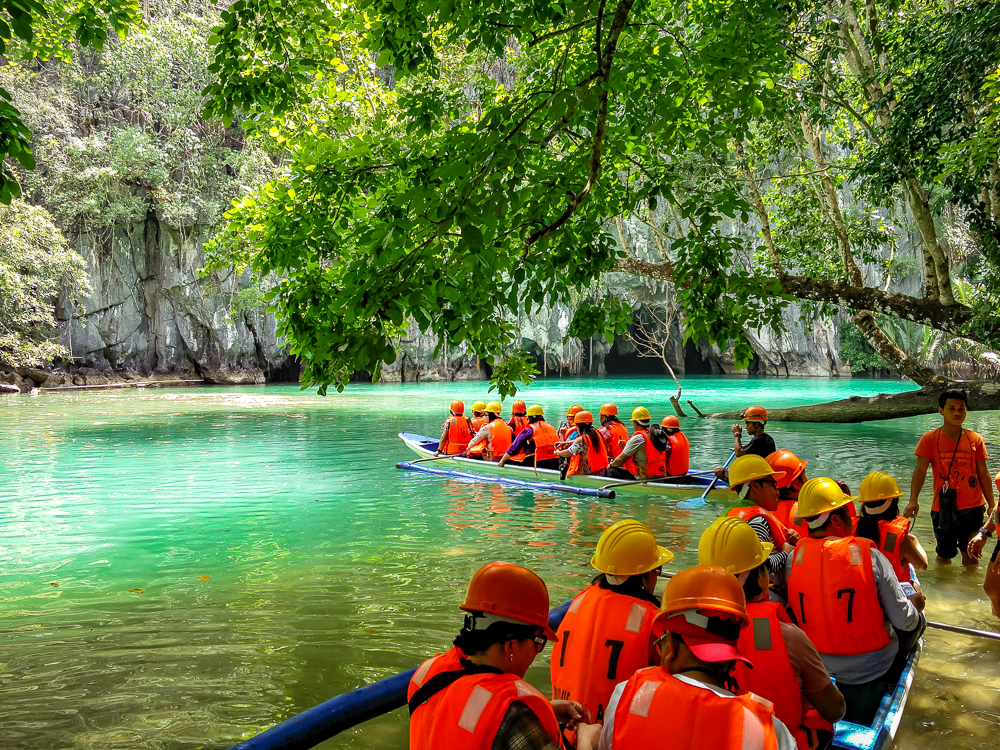
Puerto Princesa-El Nido
Afterwards, we took a van to El Nido. It was a terrible 6-hour trip in a crowded van with no headrests.
In addition to having a flat tire, the driver often stopped to talk to people on the road, offer them a lift and he even stopped at his house to pick up something. We only had one stop, to go to the bathroom and get something to eat quickly.
That was part of the adventure, but it was far from pleasant. Travel experience! Always remember that travelling is a good education for the young! hahaha
El Nido is a fishing village. You should not expect luxury. Everything is very simple around here. For those who might be interested, there are luxury resorts on some islands.

The first day, we took a tuk tuk to go to Nacpan Beach. We were 5 in the tuk tuk!
He put gasoline on the way (gasoline is sold in one-liter Coca Cola bottles). He said it was right next door, but we drove a good half hour.
The beach is very beautiful and we spent a nice afternoon. The tuk tuk driver waited for us.
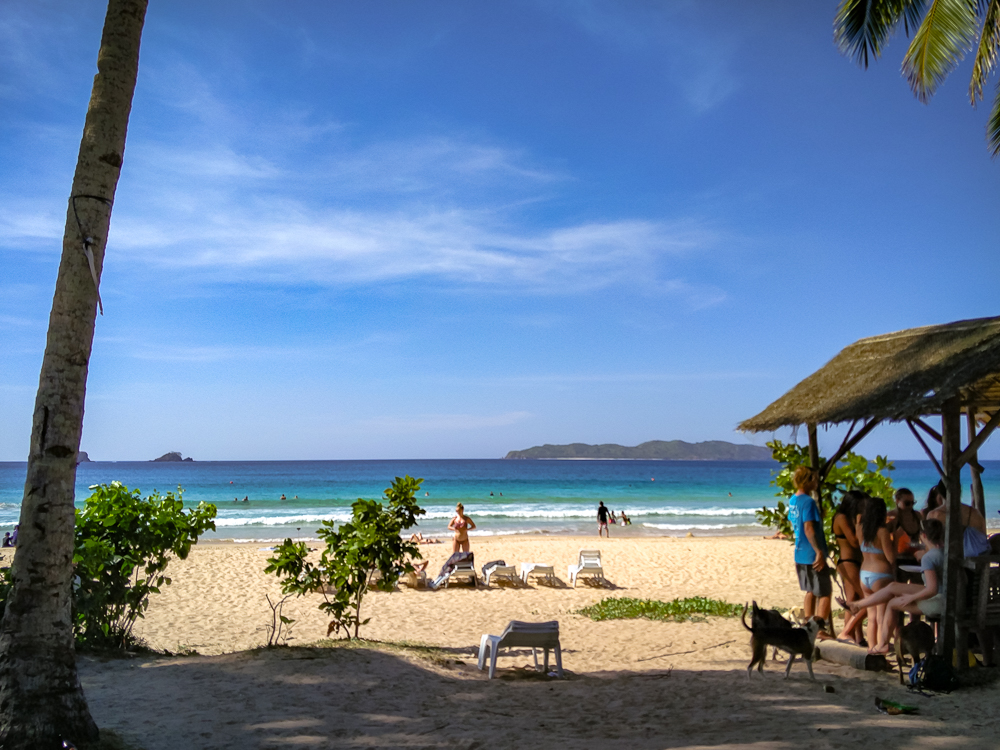
In the evening we had dinner in a restaurant by the sea, where you choose the meat/fish you want, before entering. They give us a poster with our order number.
After dinner we walked around a bit, to see the little shops. We met by chance a couple from Quebec that we had met in the check-in line at the Montreal airport.
Fun fact
In El Nido, we ended up at the police station after an argument with the hotel owner. At first, there was no water in the bathrooms. When the water arrived, it was black.
We complained to the reception and the next day the man was yelling at the employees. We didn’t understand it all, but my sister-in-law understood the part where he mentioned certain clients (meaning, us).
He was not happy to see us and rushed aggressively towards my brother-in-law. He said he was going to complain to the police (I don’t know why, because he was the one who tried to hit us…).
Finally he arrived and the chief of police made a sort of courtroom at the entrance, in the garden, where the parties could speak. The gentleman decided to leave. The police chief told us that they often had problems with him. Some merchants have told us the same thing.
We had an excursion and we were already late. We were afraid the man would do something with our things at the hotel. The people at the tour company even offered to hold our bags, just in case. Finally we left them at the hotel. Apparently no one entered our rooms.
To end the story, the chief of police invited us to dinner with all the police officers in the village. We didn’t want her to pay, but she insisted. It was a great evening with the police!
Excursions
The excursions to El Nido are offered by letter (tour A, B, C and D). I had read that tours A and C were the best, and that’s what we chose. Almost all companies offer the same service. These are day trips, with dinner on the beach included. It cost about $30 per person.
Whatever your choice, you will see beautiful landscapes.
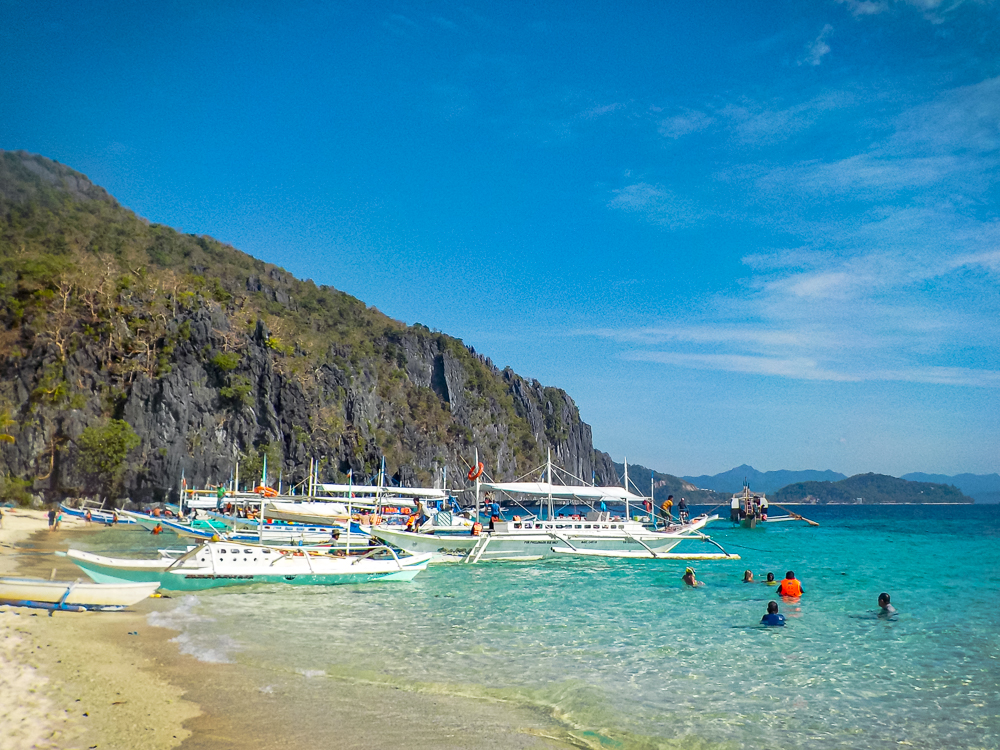
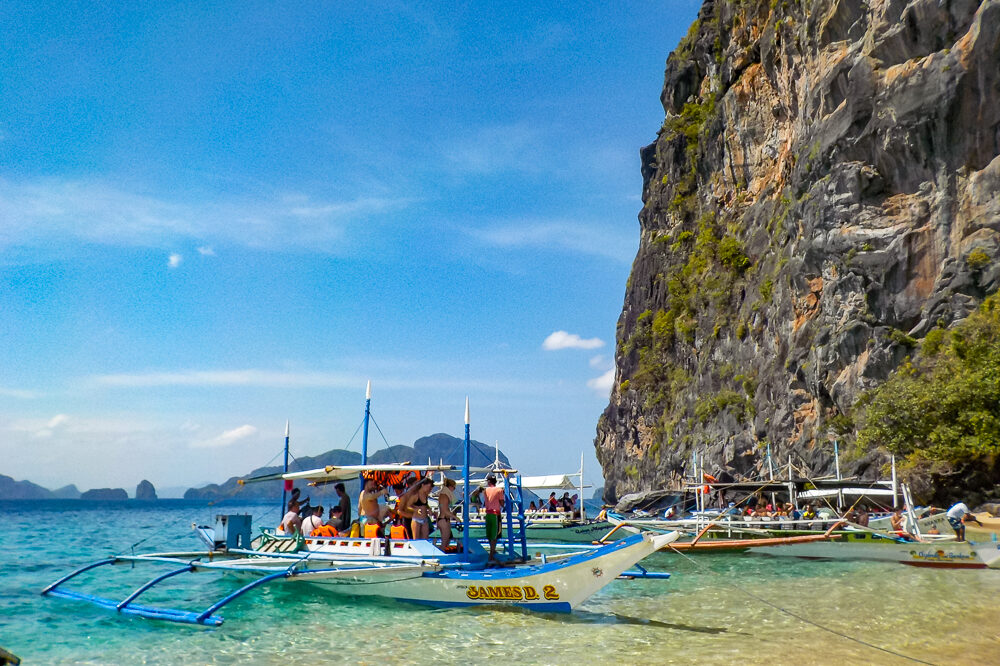
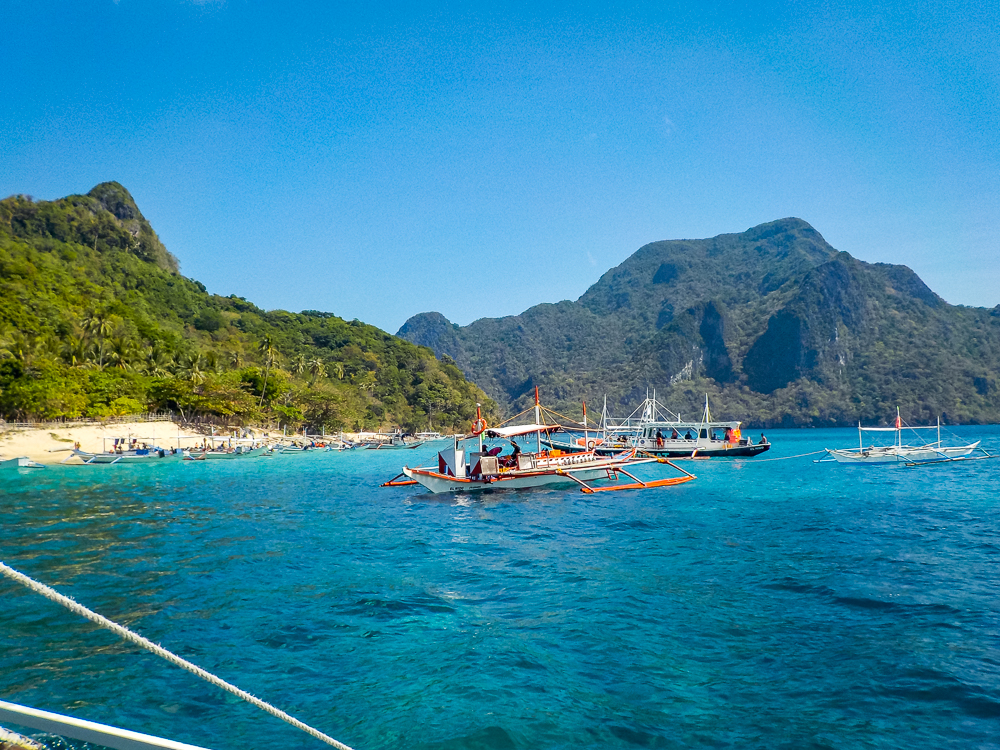
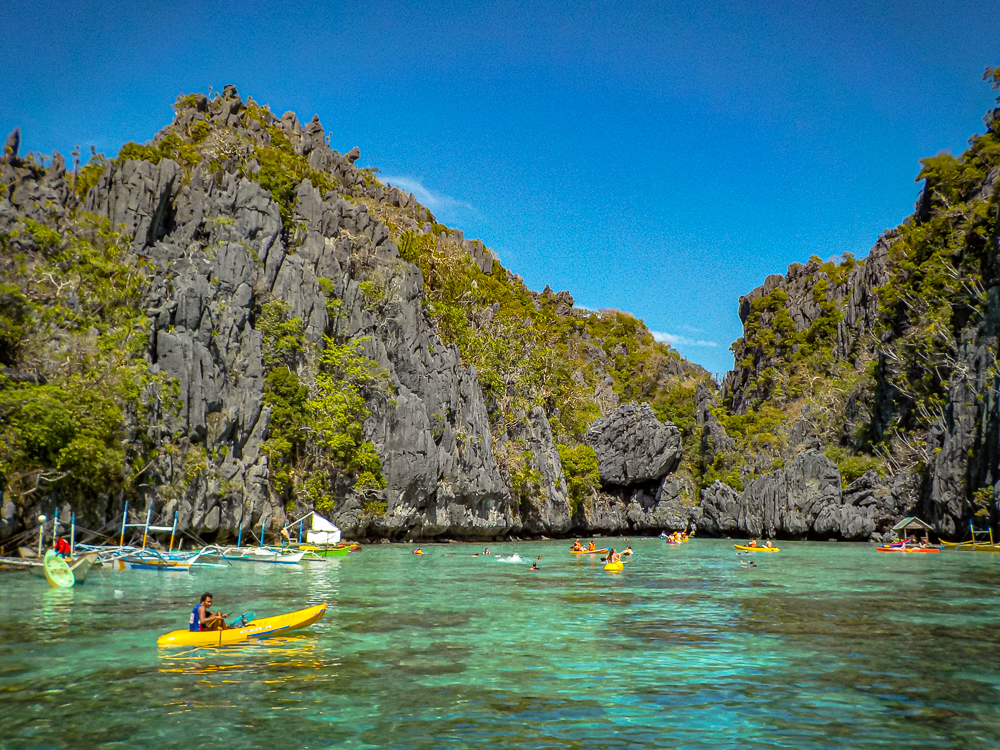
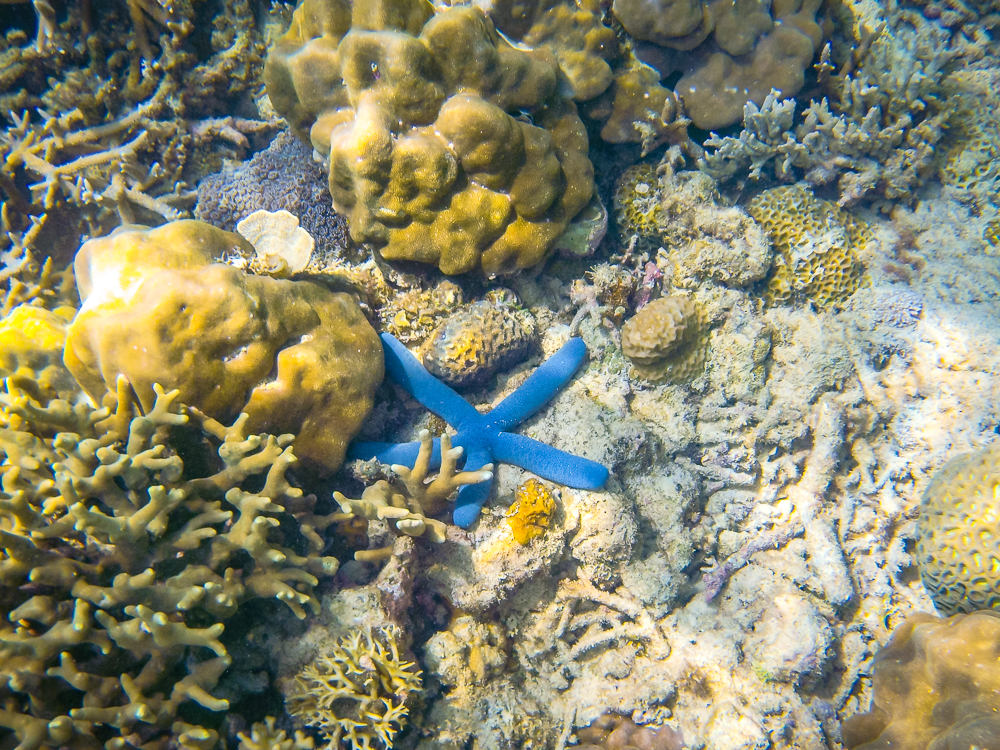
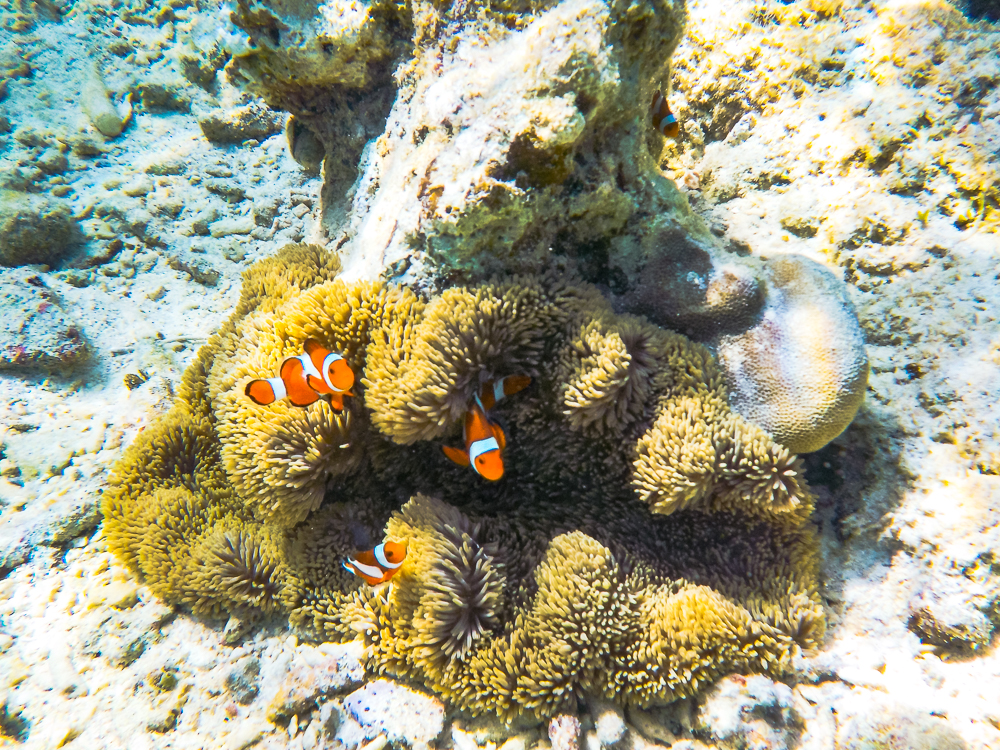

Puerto Princesa-Davao
After seeing some beautiful scenery in El Nido, we took the infamous van back to Puerto Princesa, where our flight to Davao was leaving, with a connection to Manila.
This time we didn’t get charged for the carry-ons (although they were a bit heavier than before, because of souvenirs), but the checked suitcase stayed in Manila. I was given a big $50 settlement.
We went to the airport with my sister-in-law’s brother (I know, it’s getting complicated, with a big family) to get the suitcase, the next day.
We stayed with our family in Davao for a few days before flying to Hong Kong, where we spent a few days, before returning to Manila to catch our flights home.
I will soon do an article on Hong Kong and Macau.
My opinion on the Philippines
It is still a little known country, because there is no mass tourism, as in Thailand. The main tourists are Chinese, Japanese and Korean.
I really recommend going there, before it becomes too commercial. This transformation has already begun. This can be seen in Boracay with the construction of resorts everywhere. The island even remained closed to tourists for a few months in 2018 so they could fix a problem with the hotels’ sewage.
Except for the suitcase episode at the Manila airport, I never felt like I was seen as a dollar sign on the streets. I found the salespeople to be very honest and unobtrusive.
People are poor and trying to make a living. They work very hard to get there.. They are not used to tips, and sometimes, they refused to accept them. I emptied my suitcase before leaving. I left all my clothes there and made a lot of people happy (even the hotel slippers, which were two inches longer than the feet of the person who took them). I only brought back the souvenirs I bought.
I’ve said it before, but it bears repeating: the people are lovely (except for the hotel owner in El Nido). However, time is not an important factor there. You have to be patient,because things move slowly. It took me half a day to manage to buy a SIM card in a shopping center.
The Philippines: friendly people, breathtaking landscapes, without exceeding the budget. It is a beautiful and affordable country. Despite the poverty, we never felt in danger. The locals say that you have to be careful in Manila, but we didn’t go there (only for connecting flights).
Accommodation
Hotels booked with Booking.
Marriott, Accor, Hilton and Best Western are starting to open in the Philippines, but most of the hotels were unknown to me.
If you want tips on how to get free hotel nights in the Philippines with Marriott Bonvoy, check out this article:
Our transportation
Quebec City-Montreal: Bus (120$ return);
Montreal-Beijing-Manila: Air China ($853 return);
Manila-Davao: Air Asia ($82 one way);
Davao-Cebu: Cebu Pacific (54$ one way);
Cebu-Tagbilaran: Ferry (27$ one way);
Tagbilaran-Cebu : Ferry (27$ one way);
Cebu-Boracay (Caticlan): Cebu Pacific (95$ one way);
Boracay (Caticlan)-Puerto Princesa: Cebu Pacific (243$ one way);
Puerto-Princesa-El Nido : Van (about 20$ one way);
El Nido-Puerto Princesa: Van (about 20$ one way);
Puerto Princesa-Davao: Cebu Pacific (158$ one way);
Davao-Manila-Hong Kong: Philippine Airlines;
Hong Kong-Macau: Ferry;
Macau-Hong Kong: Ferry;
Hong Kong-Manila: Philippine Airlines;
Manila-Beijing-Montreal: Air China;
Montreal-Quebec City: Bus.
All the airlines used are excellent. We flew economy class. For domestic flights, we bought all the extras available.
Rental cars
I do not advise it. The traffic is chaotic and the adrenaline is pumping pretty fast. Look for private drivers or tours.
Conclusion
This 4-week trip (Feb/March 2017) was fully paid for. No points were redeemed.
I didn’t know Milesopedia yet and their best credit card offers in Canada, unfortunately, but I thank them for the opportunity to share my experiences.
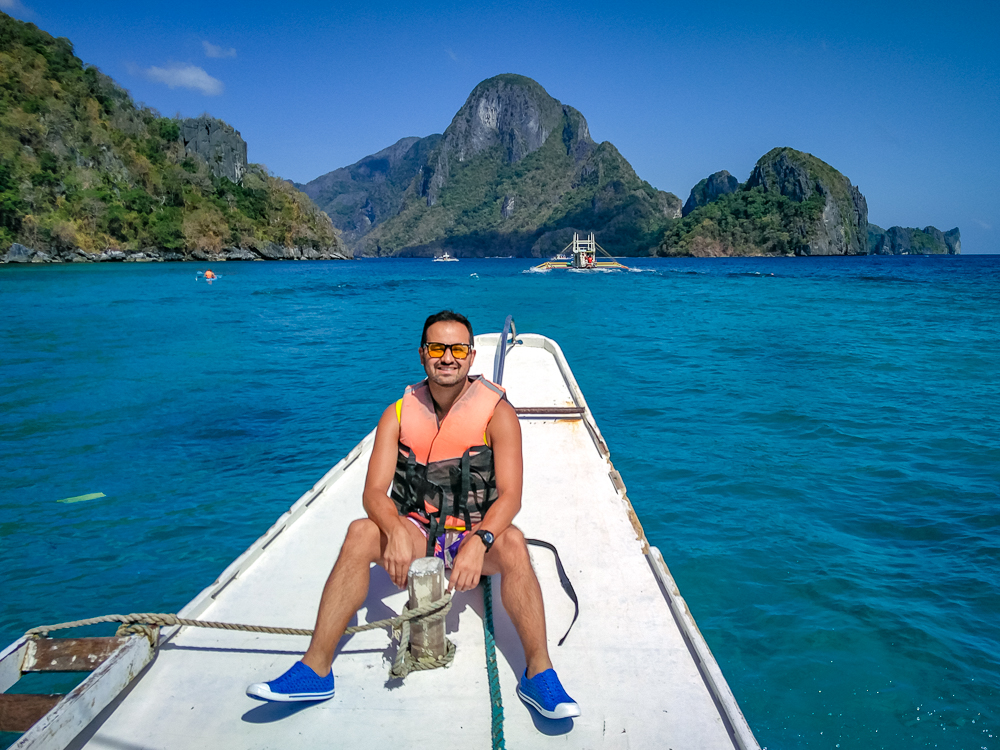
Feel free to share, comment or check out my other stories:



